A Journey through Time: Columbia’s Ancient Mediterranean Center Explores the Wonders of Western Turkey
Columbia students and faculty embarked on a 2,000-kilometer odyssey through the ancient wonders of Western Turkey.
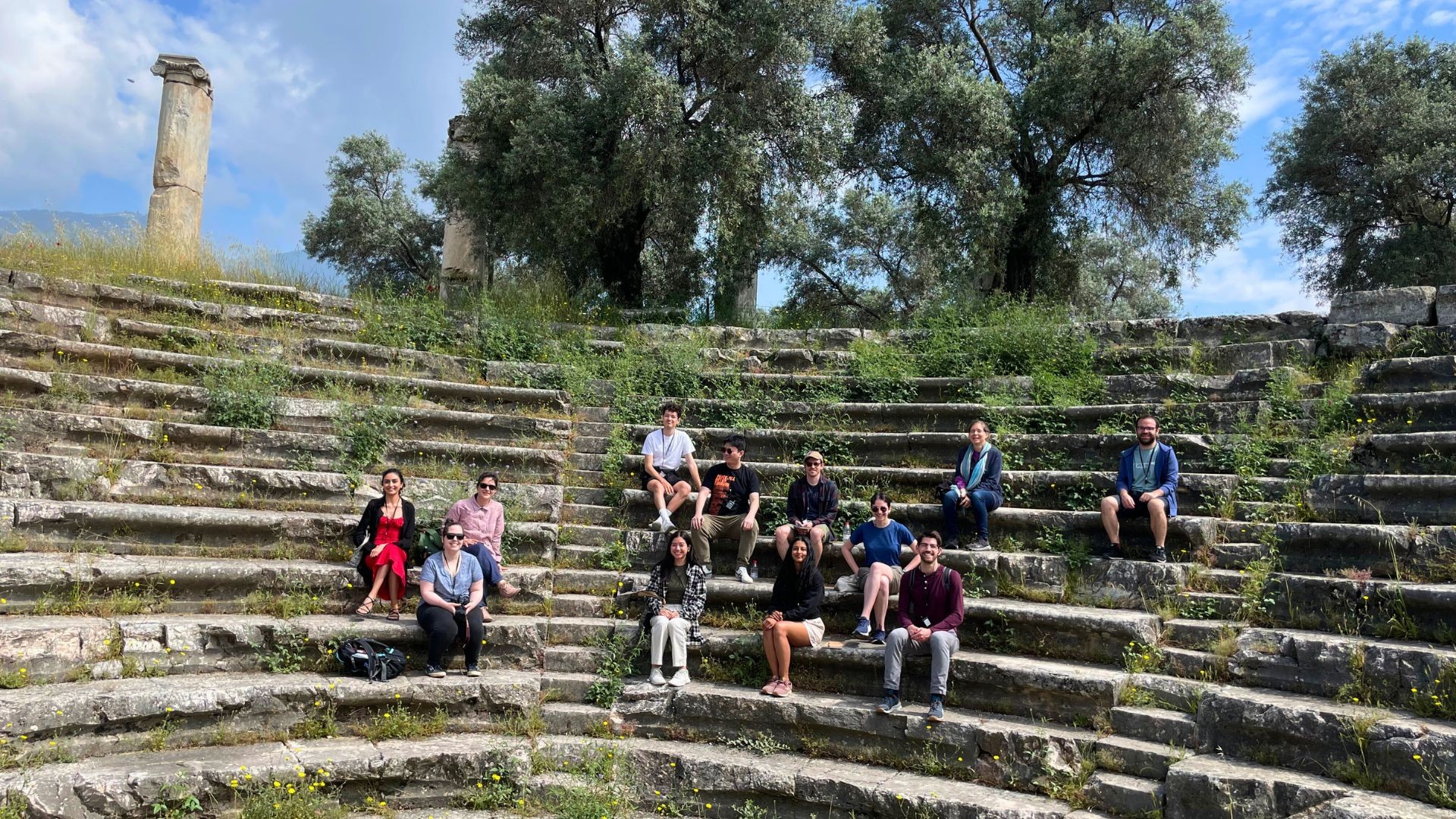
A group of Ph.D. students and faculty members from Columbia University embarked on a 2,000-kilometer odyssey through the ancient wonders of Western Turkey between May 17-27. In collaboration with Columbia’s Center for Ancient Mediterranean, Columbia Global Centers | Istanbul organized this nine-day journey on the Turkish coasts. The Istanbul Center is part of the Columbia Global Centers network, which promotes and facilitates the collaborative and impactful engagement of Columbia's faculty, students, and alumni with the world.

This journey included 17 significant ancient sites and 13 archeology museums. More than just a sightseeing excursion, this expedition was designed to offer a unique blend of academic rigor, intellectual camaraderie, and a sense of adventure that would inspire each participant to expand their horizons and explore more of these ancient wonders. From the coastal allures of Halicarnassus, Pergamon and Assos to the grandeur of Troia, Ephesus, and Constantinopolis, the itinerary showcased the legacy of the ancient Mediterranean world and beyond. The itinerary was a tapestry of civilizations, spanning the Hellenistic, Roman, Byzantine, and at some sites even the Seljuk and Ottoman eras. The pathways with their architectural wonders were the same as those taken by emperors, philosophers, and conquerors from previous eras.
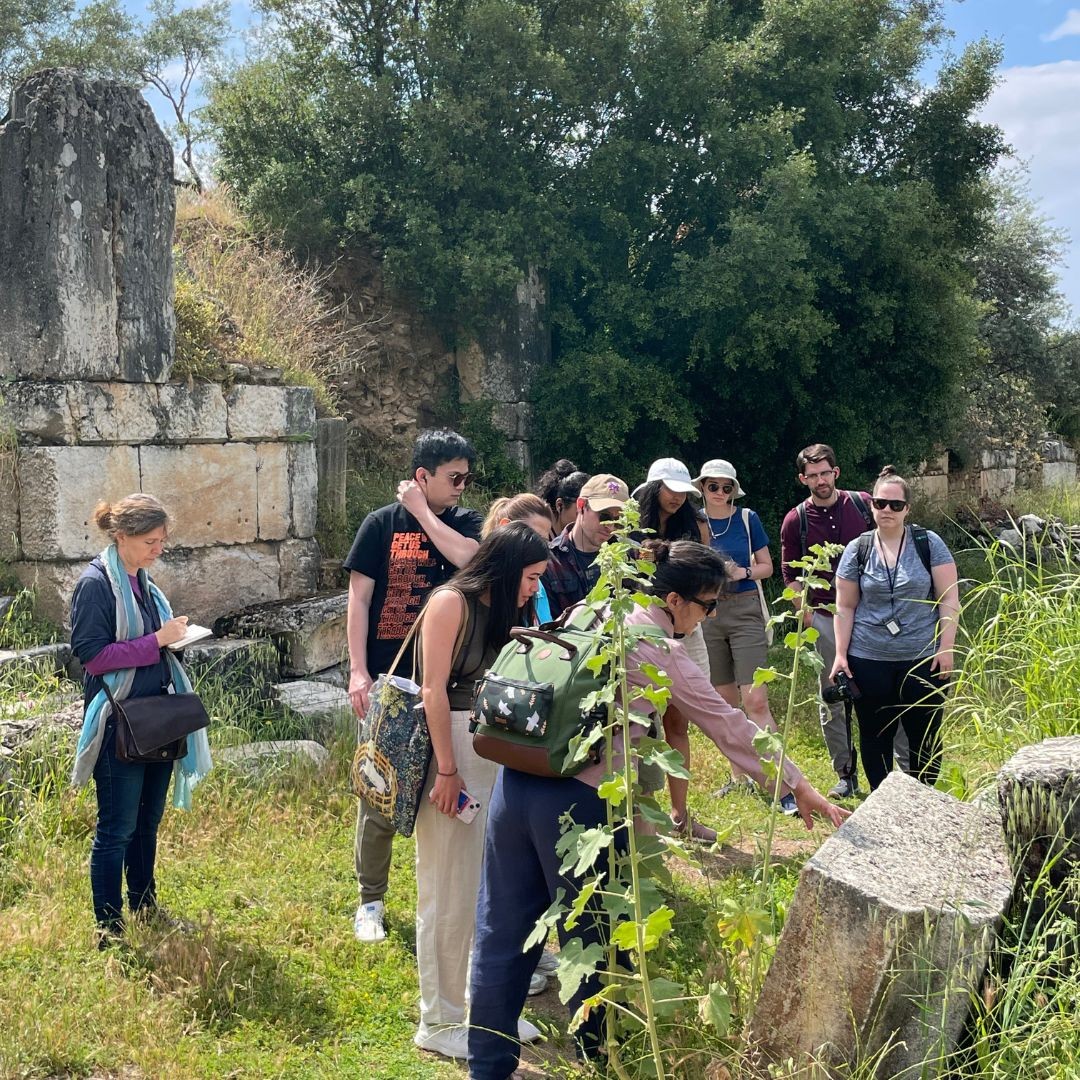
This scholarly journey provided a firsthand opportunity for the scholars to uncover the layers of history embedded in these extraordinary sites. Each day, a dedicated Ph.D. student from Columbia assumed the role of an instructor, delivering presentations that brought ancient sites to life. Accompanying us was an expert guide, adding depth to the exploration.
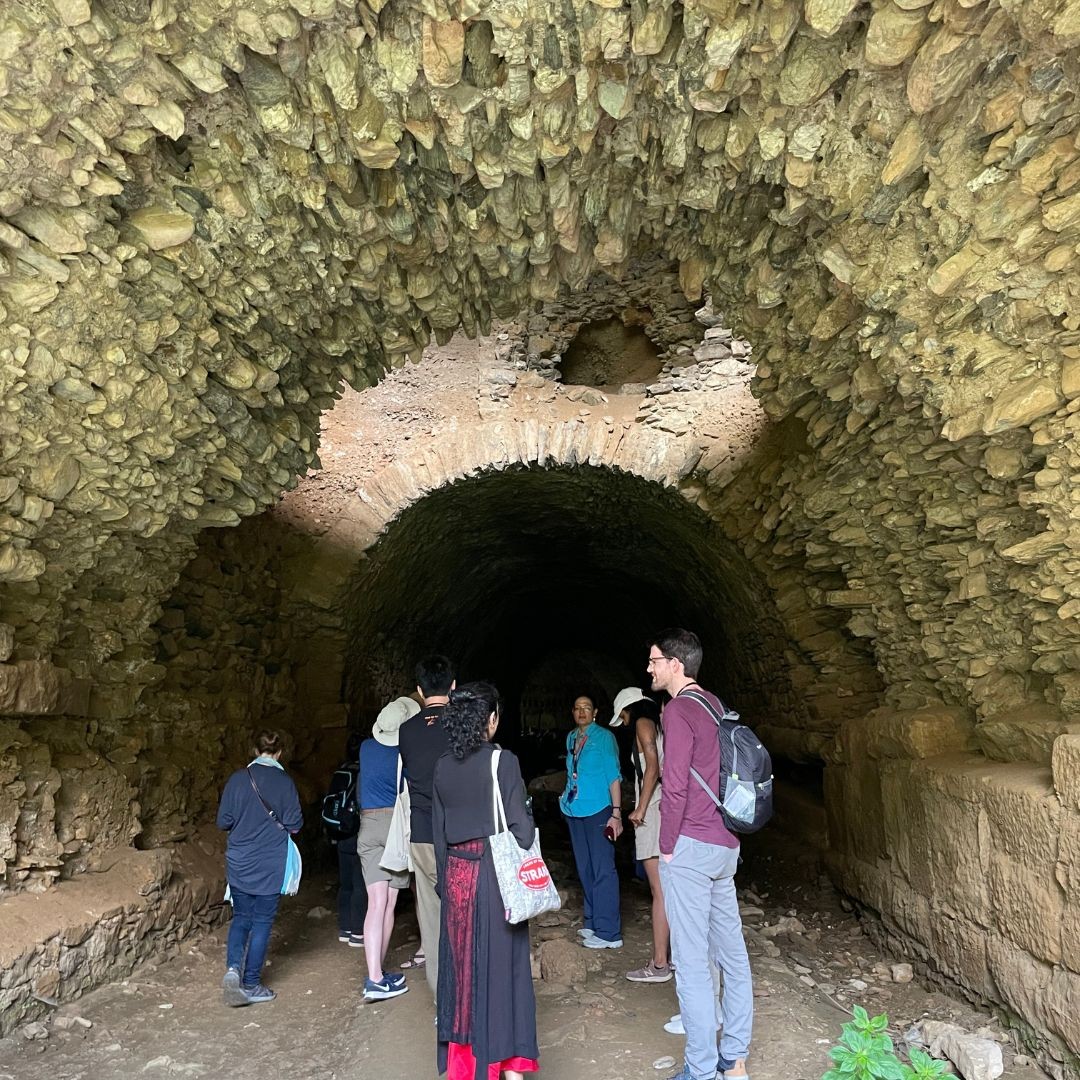
The trip concluded in Istanbul, once Constantinopolis, a city straddling two continents and serving as a living testament to the passage of time. As we bid farewell to each other, we carried with us not only the memories of the sites we explored but also the aspiration to continue unraveling the ancient world.
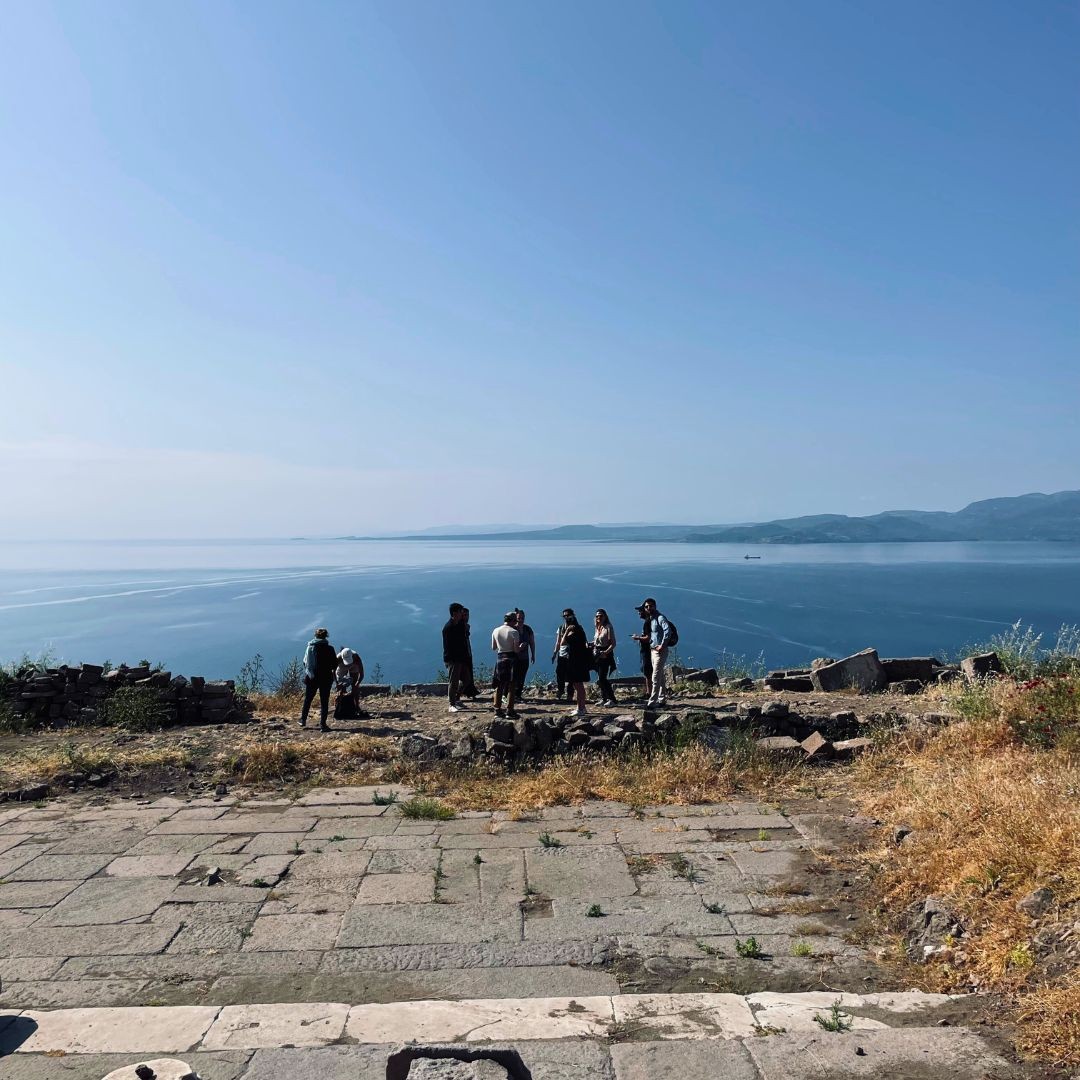
In sharing our travelog, we hope to ignite a shared sense of inspiration and curiosity. Having been part of this extraordinary odyssey as Columbia Global Centers | Istanbul, we can attest to the impact that such experiences have on one's intellectual growth.
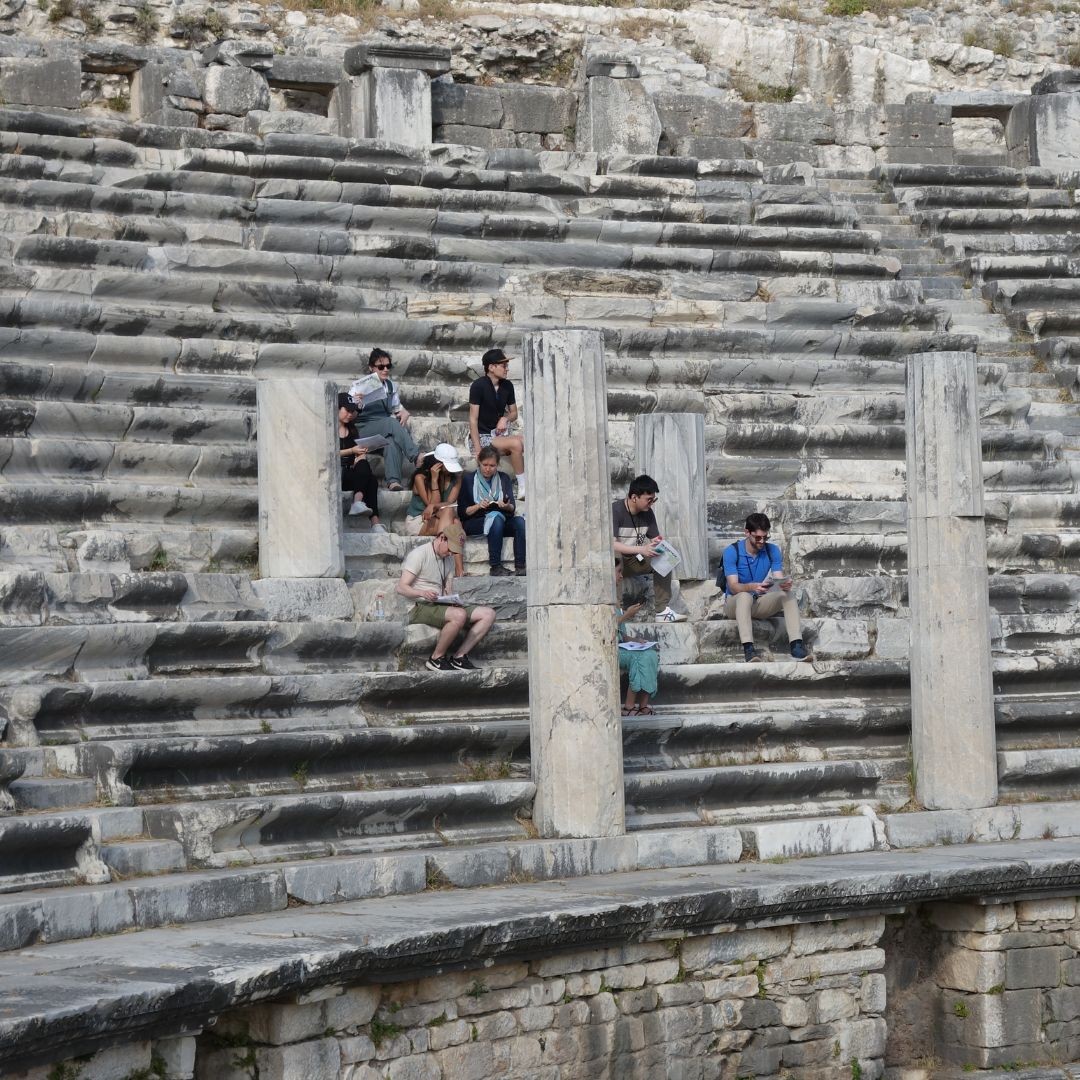
Our expedition started in Bodrum in Southwest Turkey, many kilometers away from Istanbul. We commenced with an exploration of the ancient city of Halicarnassus, starting from the Myndos Gate. Built in the 4th century BCE, this grand structure shows how powerful and wealthy Mausolus, ruler of the Caria region and satrap of the Achaemenid Empire, was.
Our next stop was one of the Seven Wonders of the Ancient World, the Mausoleum at Halicarnassus. The Mausoleum stood as a majestic structure built for Mausolus and his wife Artemisia II once, fascinating the visitors with its architecture and sculptures combining elements from the East and the West. Though time has taken its toll, the remnants still spoke of a bygone era.
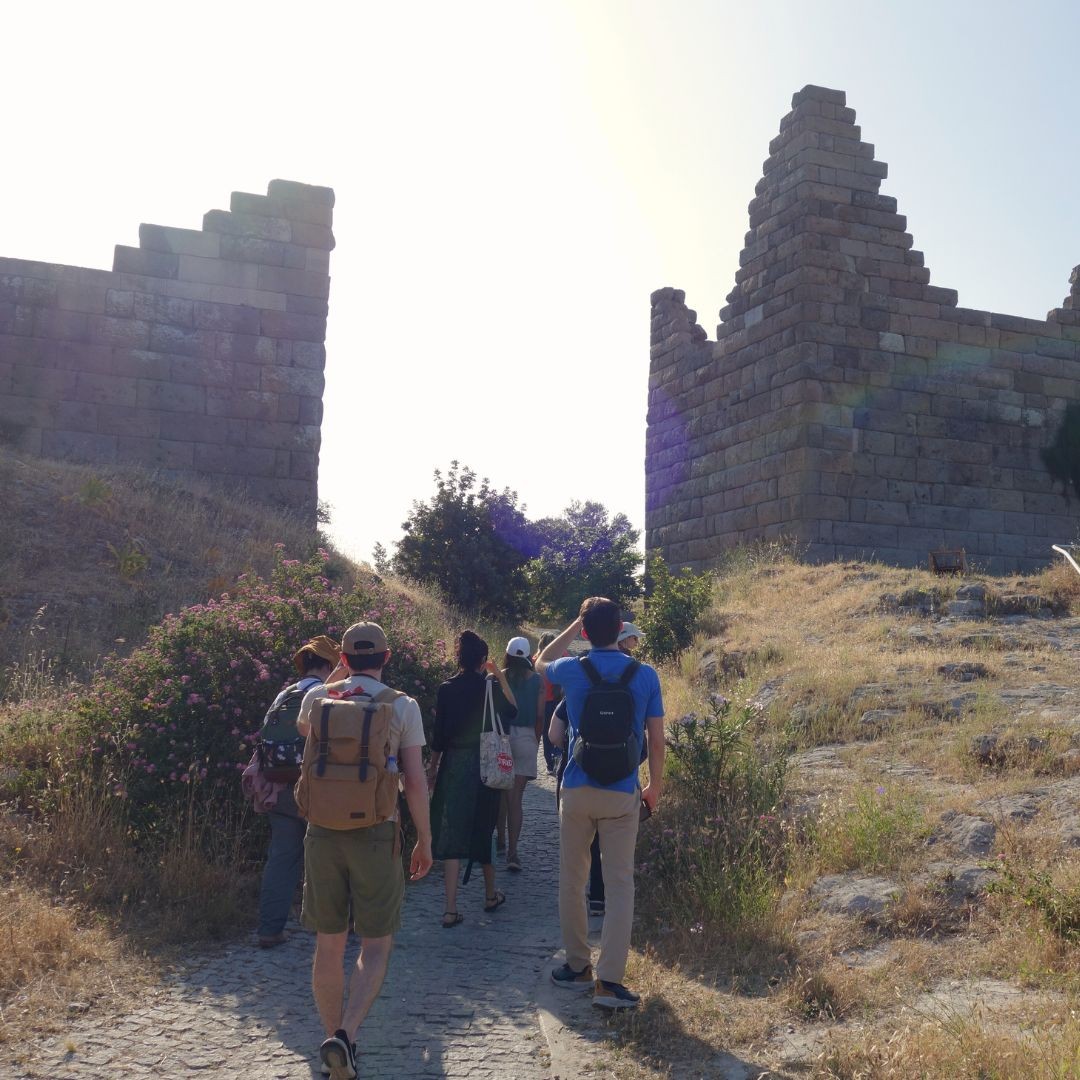
Continuing our journey, we found ourselves in the presence of the Bodrum Castle, a fortress built by the Knights of Rhodes that has stood sentinel for centuries. Our exploration led us to the Serçe Limanı Glass Shipwreck exhibition inside the Castle, an archaeological marvel from beneath the waters of the Mediterranean. Dating back to the 11th century CE, this sunken ship revealed glimpses of a seafaring past, showcasing the remnants of a merchant vessel and its cargo. As we gazed upon this submerged treasure, we imagined the maritime trade that once thrived in these waters.
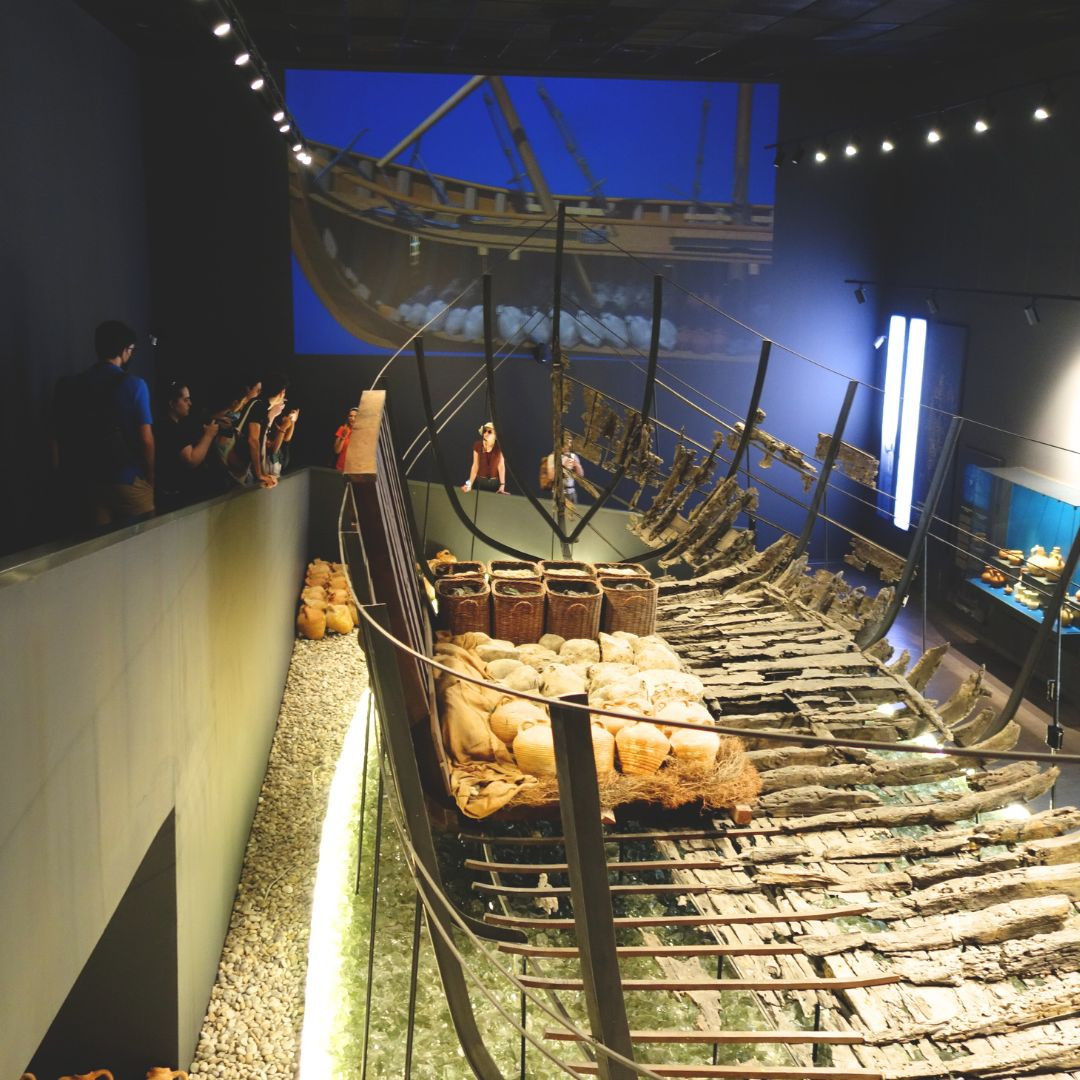
We were privileged to visit the Temple of Apollo at Didyma after an hour’s drive from Bodrum, a site of prophecy for ancient times. This temple complex dedicated to the god Apollo mesmerized us with its colossal size and architectural details. Just a few kilometers from the temple was our final stop for the day, the ancient city of Miletus. A bustling hub of trade and culture in the ancient world, the site welcomed us to explore its ruins and wander through its four ports.
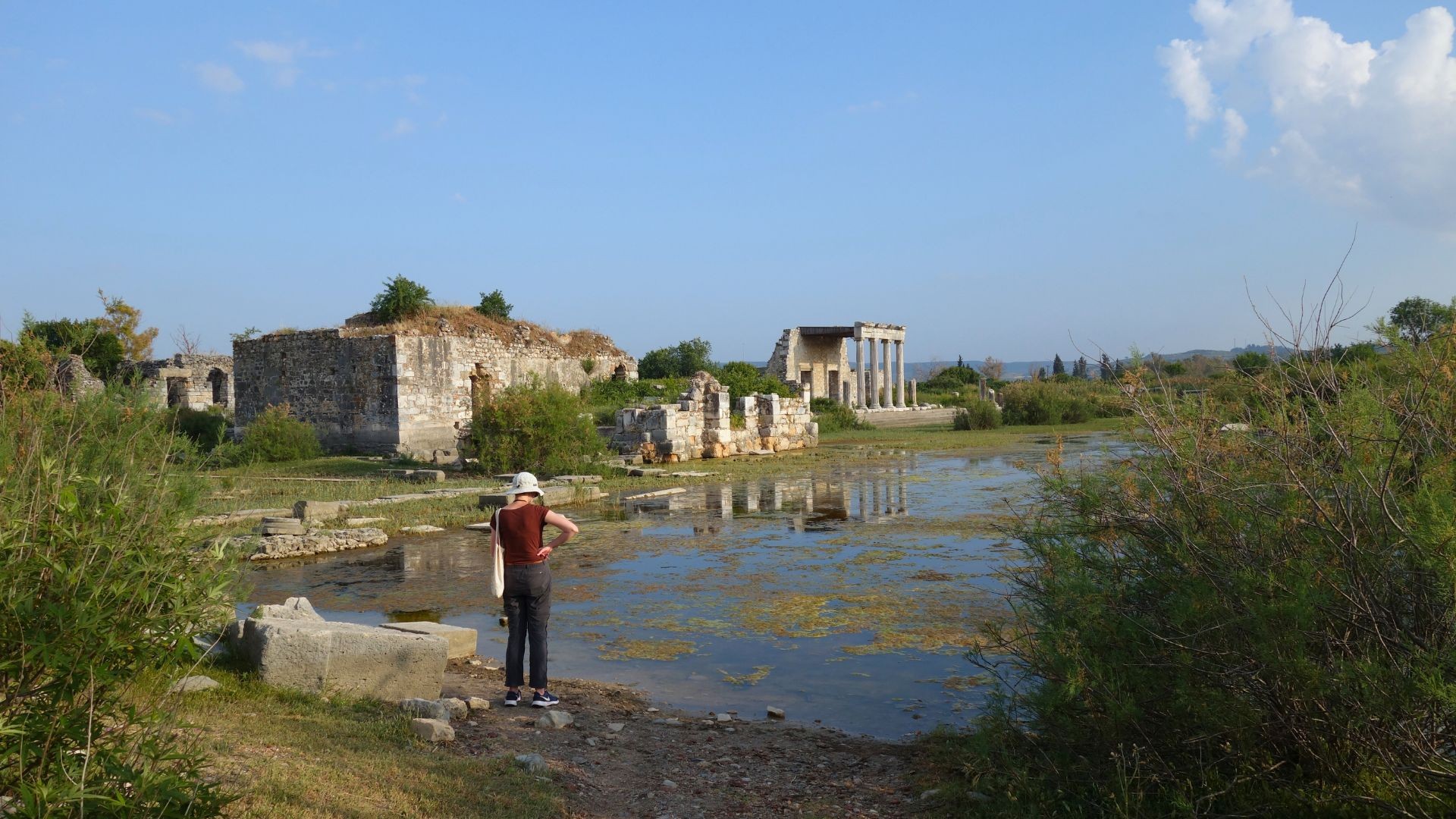
Beside being renowned for its strategic location and maritime power, Miletus was also famous for its contributions to philosophy. With a colleague from Columbia’s Classics Department with a philosophy background, it was impossible not to mention Thales, one of the Seven Sages of Ancient Greece and a prominent figure in the early development of scientific thought.
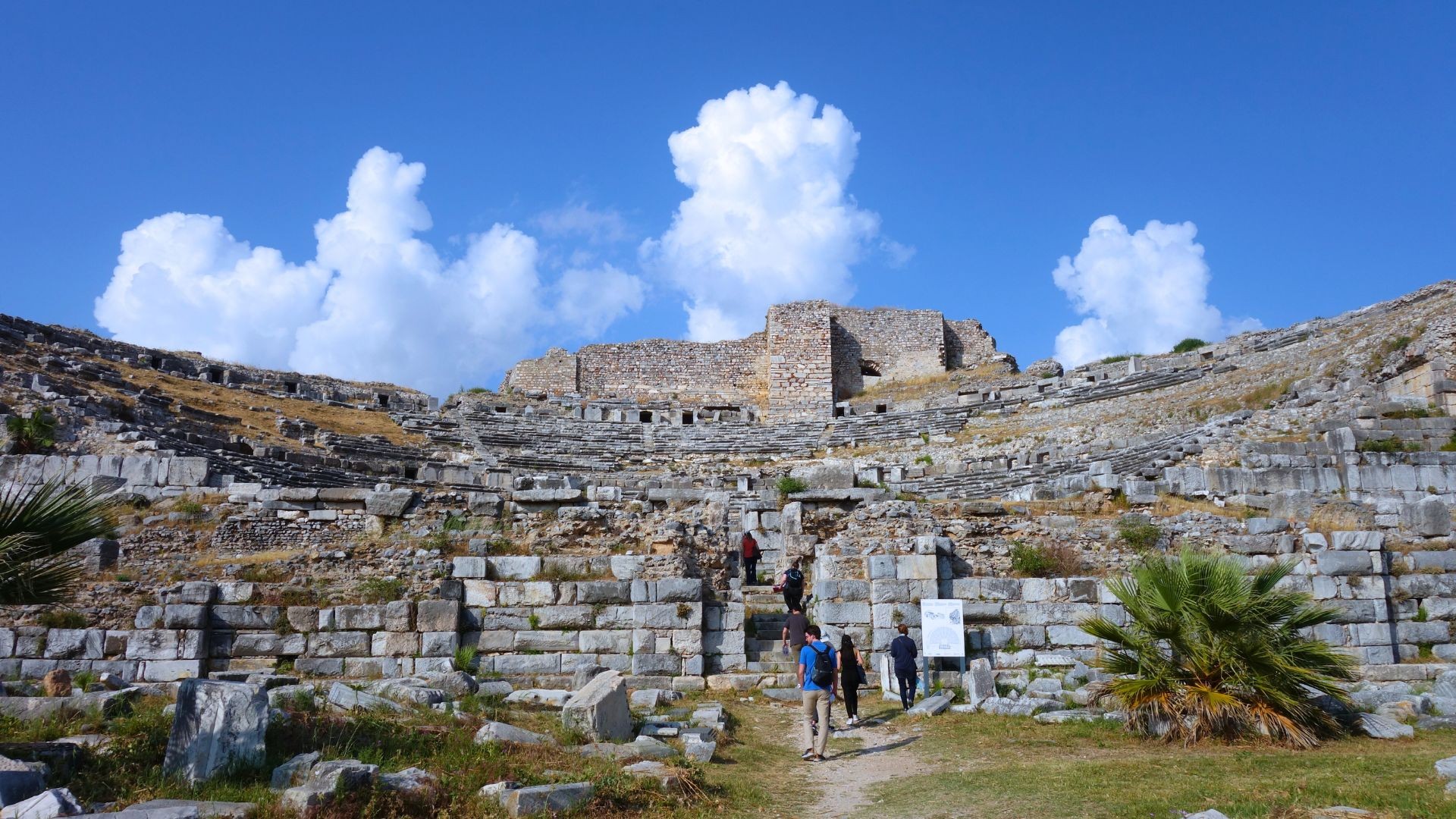
As the sun set on our first day, we left behind the ancient wonders of Bodrum and its surroundings, preparing ourselves for the next day.
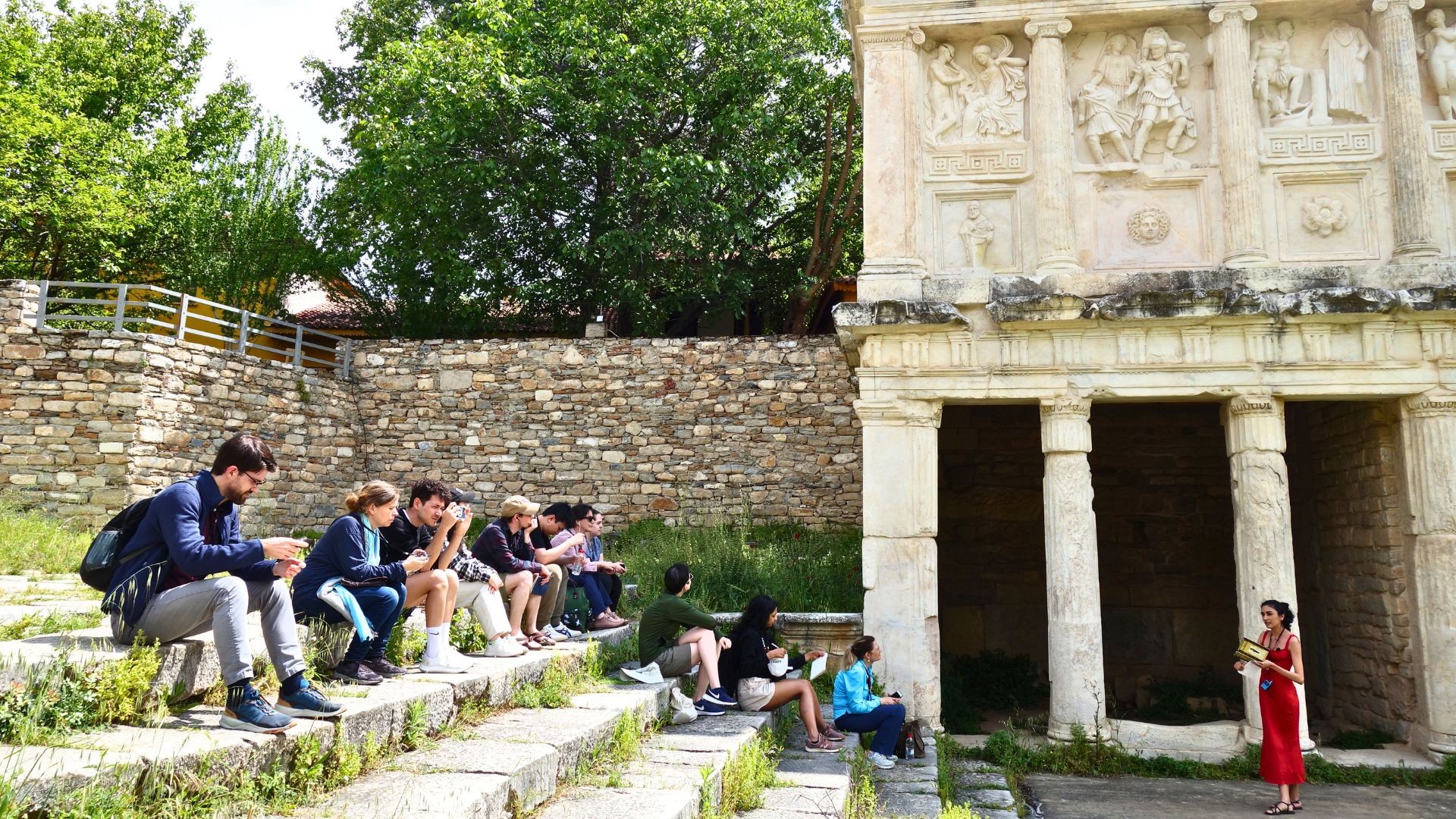
Our second day started at the city of Aydın, a city rich in history and archaeological sites. At the Aydın Archaeological Museum, we delved into the history of the surrounding ancient cities, including Carian cities of Alinda and Alabanda. Immersing ourselves in the artifacts and exhibits, we learned more about the stories of ancient Anatolian mainlanders from before the Ionian era.
Continuing our expedition, we arrived at the ancient city of Nysa, a place with many mythical tales and architectural splendor. Nysa was said to have been the birthplace of Dionysus, the Greek god of wine and revelry. According to legend, Dionysus was born to the mortal princess Semele and Zeus, the king of the gods. Zeus disguised himself as a mortal to be with Semele, but her doubts led her to ask him to reveal his true form, resulting in her tragic demise. However, Zeus saved their child, Dionysus. As he grew older, he discovered the art of winemaking and taught it to humanity, spreading the cultivation of grapes and consumption of wine. Ancient festivals honoring Dionysus thus initiated, occurring every spring when grapevines bloomed anew.
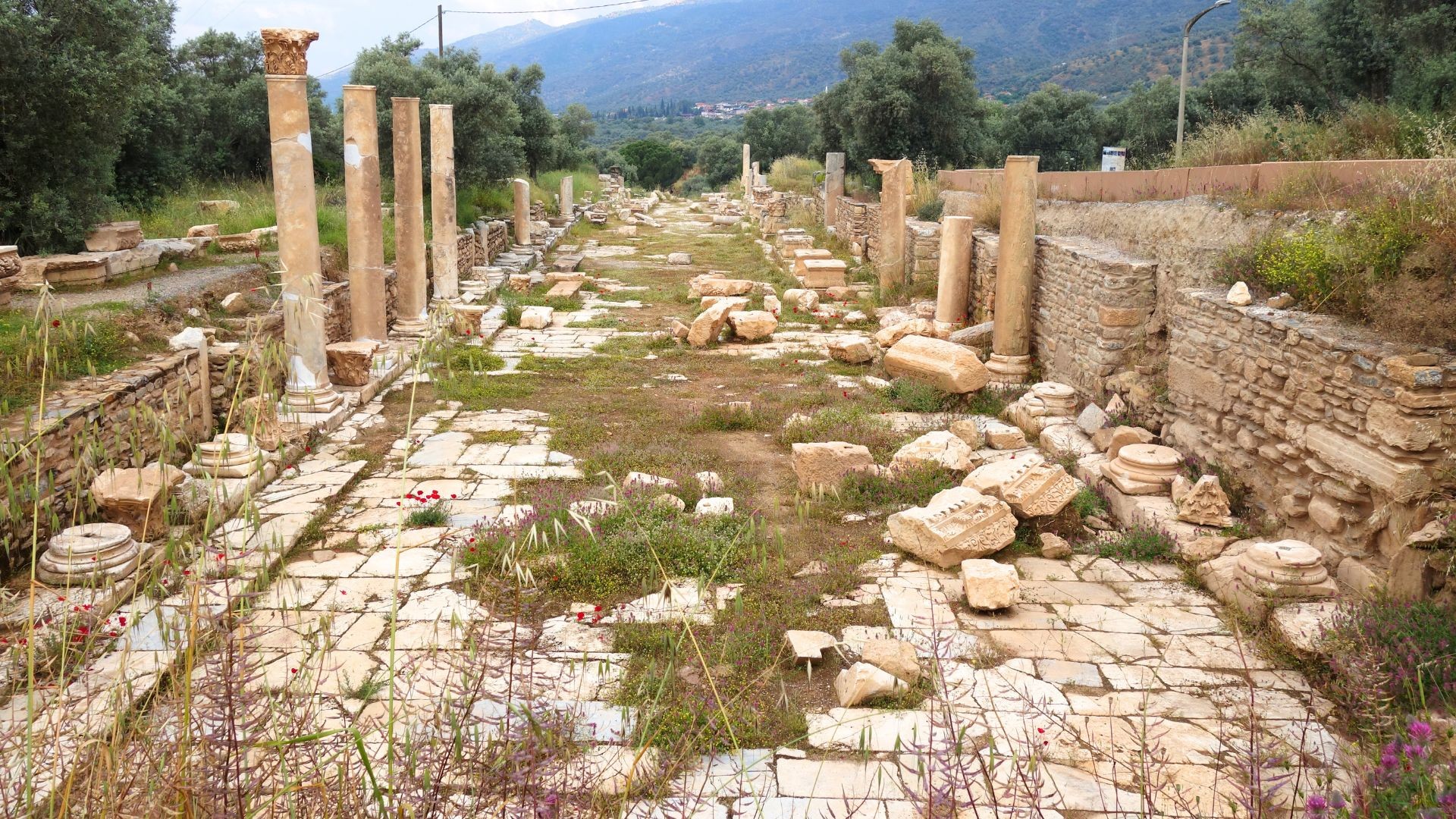
A significant component of these festivals was theater, with numerous plays written specifically for performance during these springtime celebrations. Walking among the ruins, we were struck by the Nysa’s impressive amphitheater, one of the three in Turkey. Visualizing the plays and performances that once took place within its stone walls, we were impressed by the artistic prowess of the ancient inhabitants.
After an 80-kilometer bus ride, our final destination for the day was Aphrodisias, a city renowned for its significance to Roman emperors. Our visit began with the sebasteion, a 1st century CE temple complex dedicated to emperors. The building has three floors, each of which is decorated with a different order of column, respectively Doric, Ionic, Corinthian. The upper two floors were decorated with marble reliefs too. Susan Rahyab, Ph.D. Student, Classical Studies, our presenter for the day, underlined how these reliefs reflect the realities of Roman imperialism and brutality with the images of the emperors as conquerors of various regions.
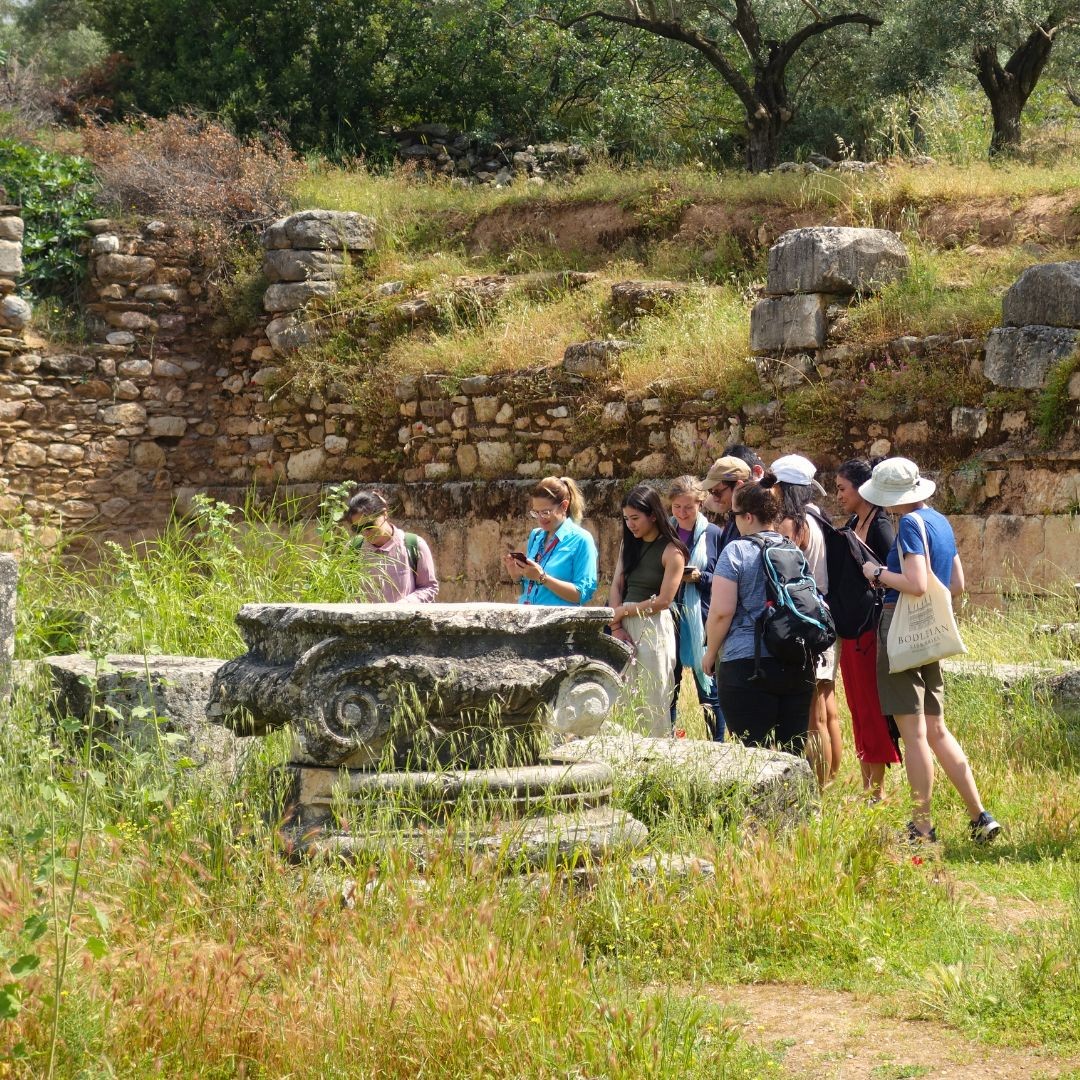
Originally named after the goddess Aphrodite, the deity of love and beauty, it was here that the people worshiped her, and their devotion manifested in the construction of a magnificent temple dedicated to her cult. As we explored the temple ruins, we were transported to a time when the city was a hub of spiritual reverence.
Aphrodisias was also a place of celebration and athleticism. Its grand stadion with a capacity of c. 30,000 people was a testament to the spirit of competition and physical excellence. Being the best preserved of all ancient Greek stadia and also one of the largest, the stadion accommodated traditional Greek athletic contests and was used for gladiatorial combats and wild-beast fights during festivals.
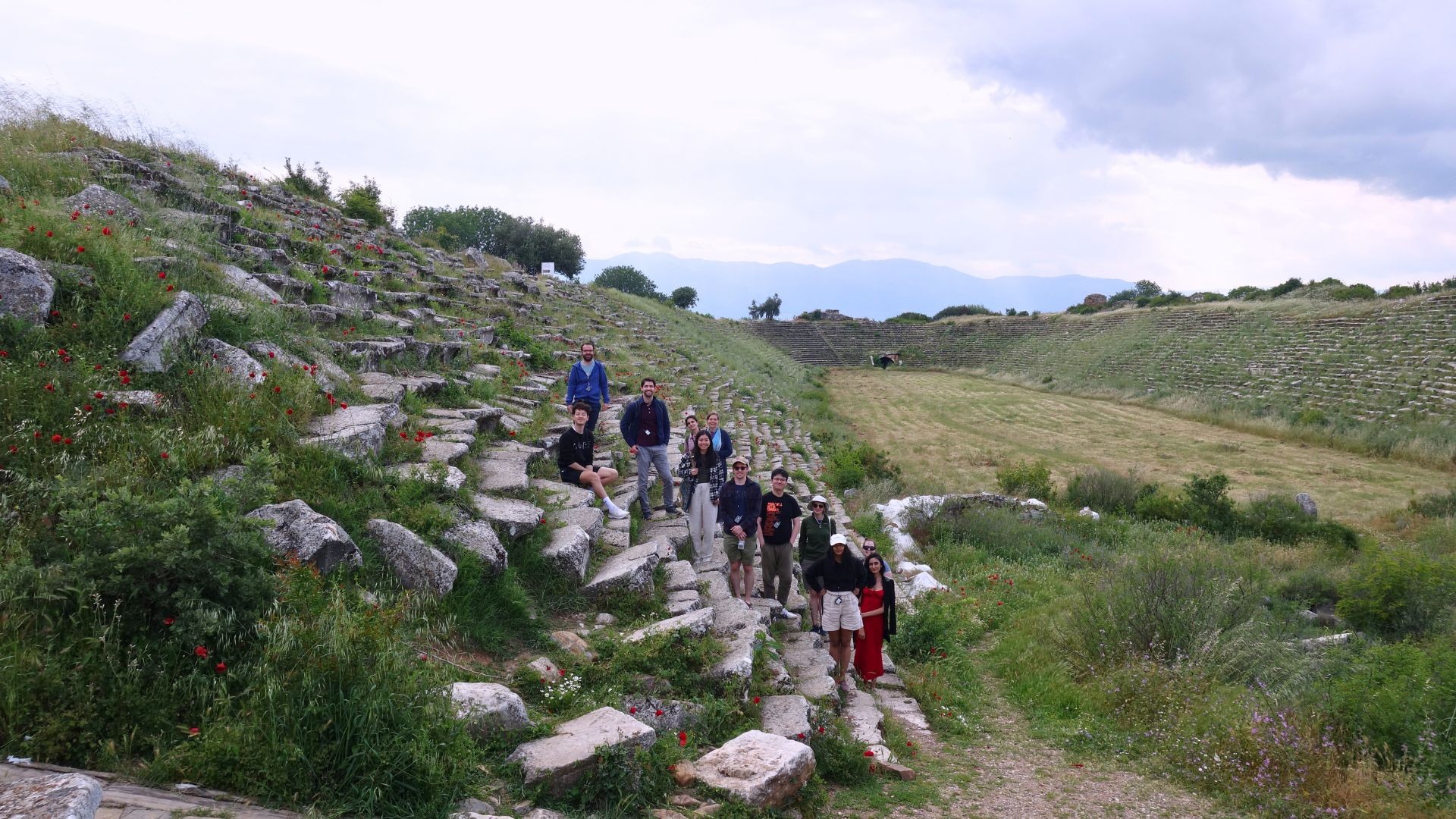
The city's theater was another highlight of our visit, which houses a fascinating archive of inscriptions. These offered insights to the political intrigues and power struggles that unfolded in the city, allowing us a glimpse into the political landscape. We were able to read, discuss, and analyze parts of these inscriptions thanks to our expert group of Columbia students and faculty members. This enriched our understanding of the context and shed light on the dynamics of the era.
We also came upon intriguing evidence to the economic policies of the Roman Empire, the Price Edict of Diocletian. Issued in the 3rd century CE, this edict aimed to regulate prices and stabilize the economy. We discovered the far-reaching implications of this edict on trade, commerce, and daily life in the Roman world, as it sought to control inflation and ensure the availability of essential goods. Its impact on market dynamics was a matter of hot debate in the group.
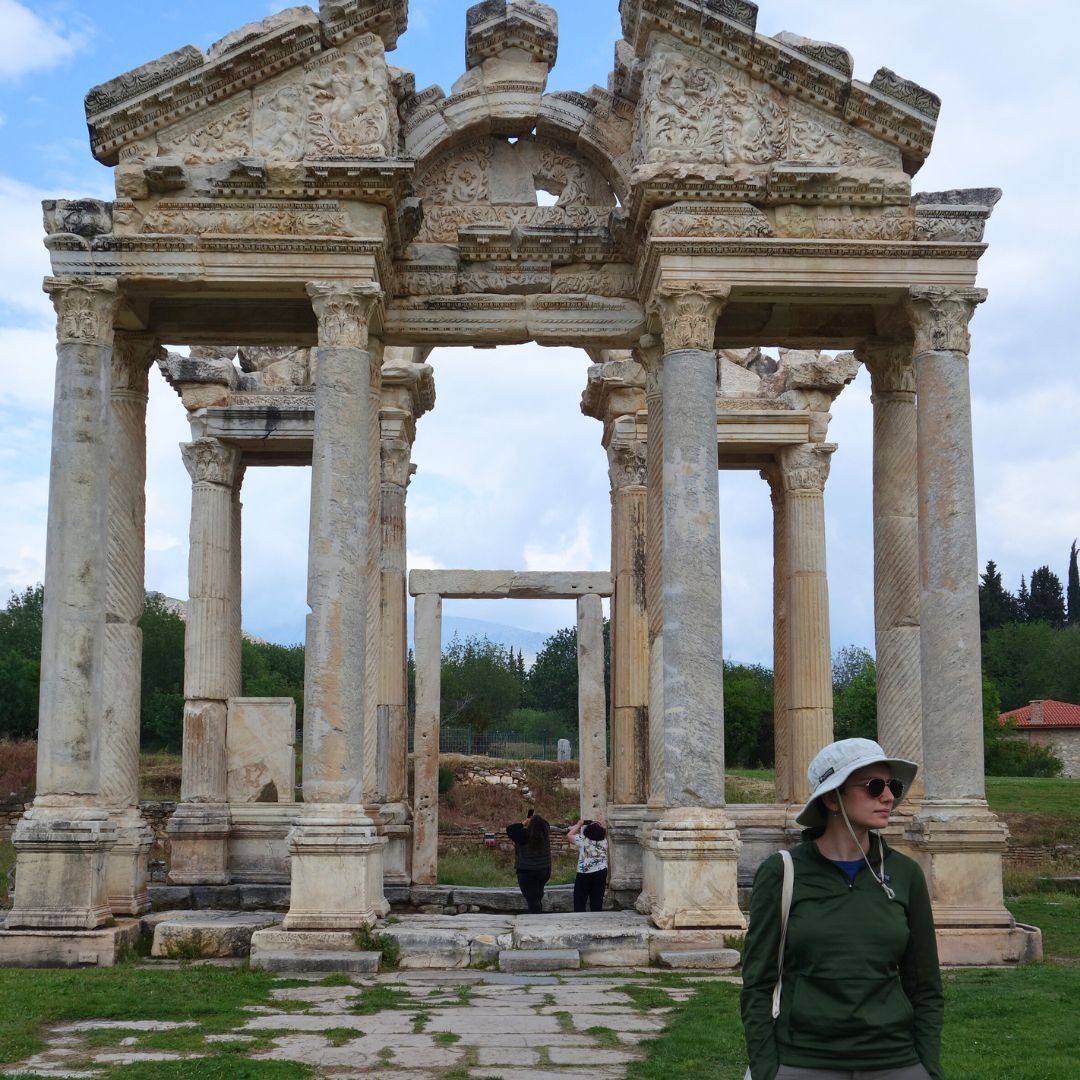
As the day drew to a close, we departed Aphrodisias with appreciation for its historical legacy. The legends, the cultural celebrations, the political legacies, and thinking about the economic lives of thousands of ancient citizens all converged in this remarkable city.

The third day of our journey led us to explore the ancient cities of Hierapolis and Laodicea. The former sits on a mountain ridge, while the latter is adjacent across the Lycus Valley, each is visible from the other. Our first destination, Hierapolis, was founded in the 2nd century BCE and thrived under various rulers, including the Hellenistic Seleucid Empire and the Roman Empire.
Starting to explore the ruins of Hierapolis, we were immediately drawn to the necropolis, or the city of the dead, which was an integral part of ancient societies, reflecting their beliefs about maintaining a connection between the living and the dead. A burial ground for thousands of years, Hierapolis’ necropolis with more than 1,200 tombs and 300 inscriptions, showcases the various customs surrounding death. Our presenter for the day, Brett Lee Stine, Ph.D. Student, Classics, reflected that it was not at all possible to fully understand the impact of a necropolis until entering this site personally and walking among the tombs and large structures.
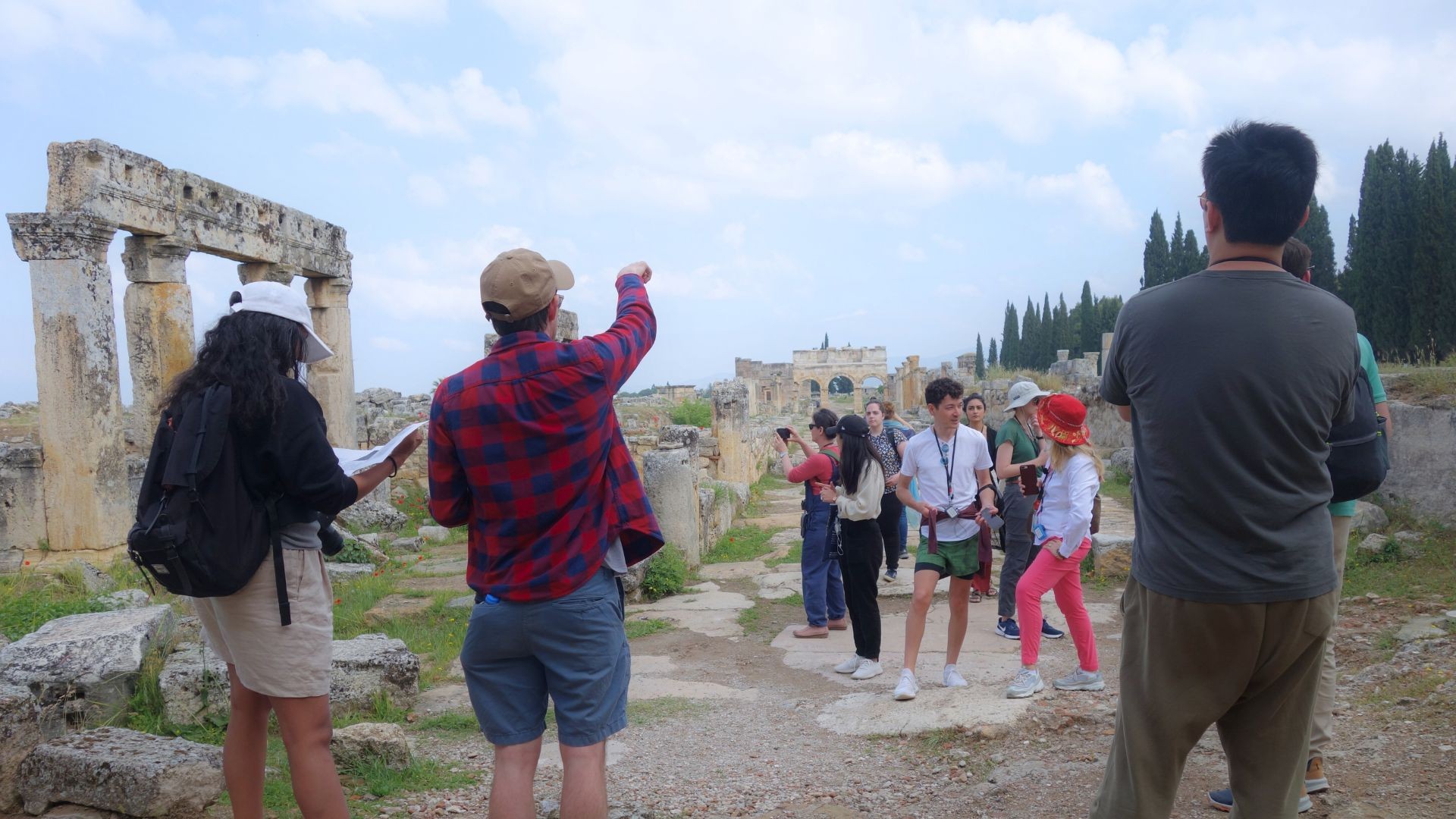
Among these were the famous “Cursed Tomb.” The inscription around this sepulcher refers to the curses inflicted upon those who violate it, invoking diseases, as well as punishments in the next world. Being reminded of the mystical allure of ancient civilizations, our group engaged in discussions regarding the motivations behind the presence of curses as such, debating their significance in relation to worldly laws and governing authorities.
Continuing our journey through the city, we arrived at the Apollo Temple. This impressive sanctuary held great religious and cultural significance. Among the unique features of this temple was the alphabetical oracle which allowed visitors to seek answers by selecting letters. We eagerly participated, choosing letters that represented our names and read responses we would have heard from the oracle.
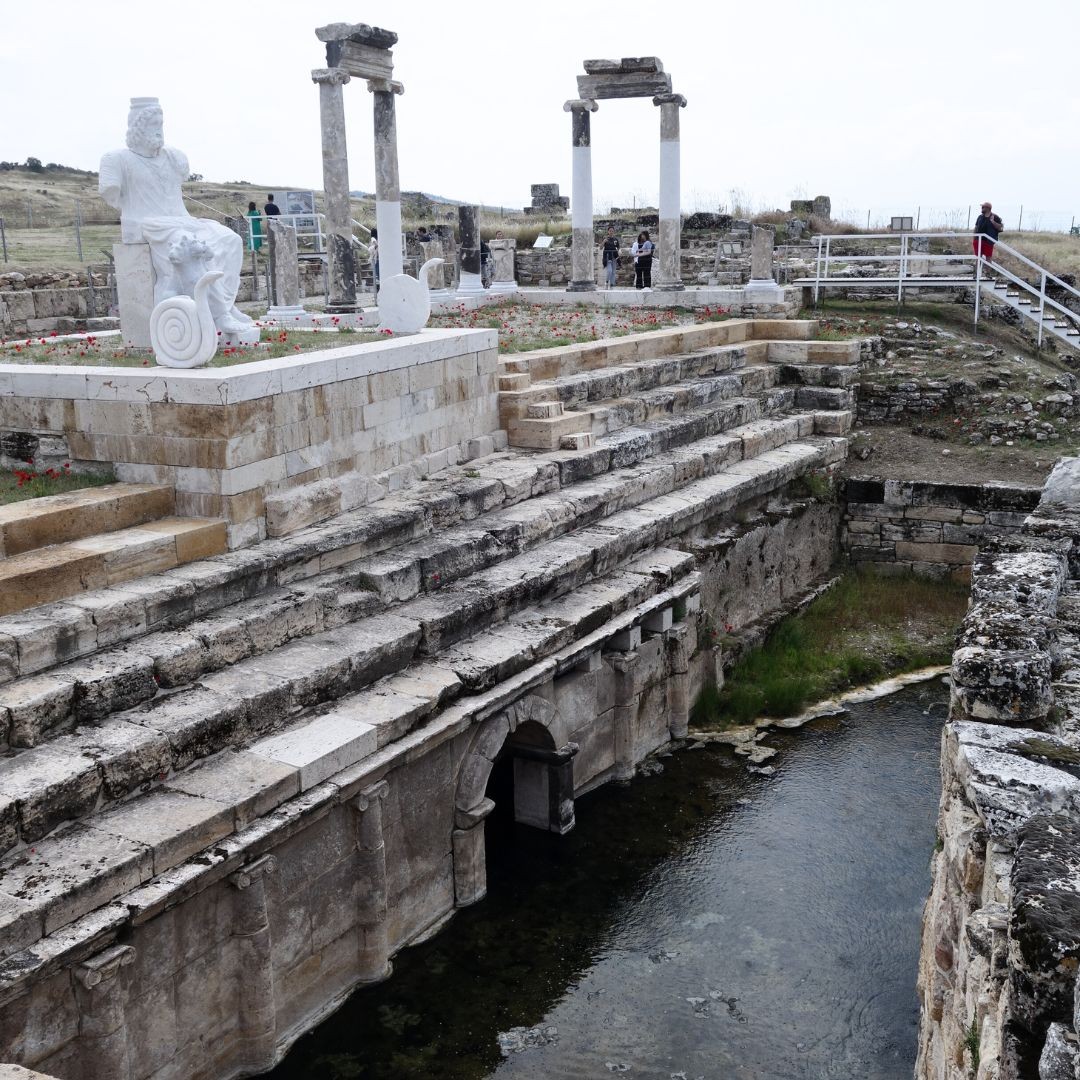
Ploutonion, or Pluto's Gate, was our next stop. This unique geological formation, also referred to as the “gate to the underworld,” had immense mythological and cultural value. The site emitted toxic gasses, primarily carbon dioxide, making it perilous for any living creature to approach. According to ancient beliefs, it was an entrance to the realm of Pluto, or Hades in the Greek times, the god of the underworld. The gate was thus adorned with sculptures depicting Hades and Cerberus, the three-headed dog guarding the entrance to the realm of the dead.
Before we left Hierapolis, we couldn’t help but marvel at the stunning travertines of Pamukkale. These terraces, formed by the accumulation of calcium-rich mineral deposits from the nearby hot springs for thousands of years, created a natural spectacle. We walked barefoot along the gleaming white formations, enjoying each step.
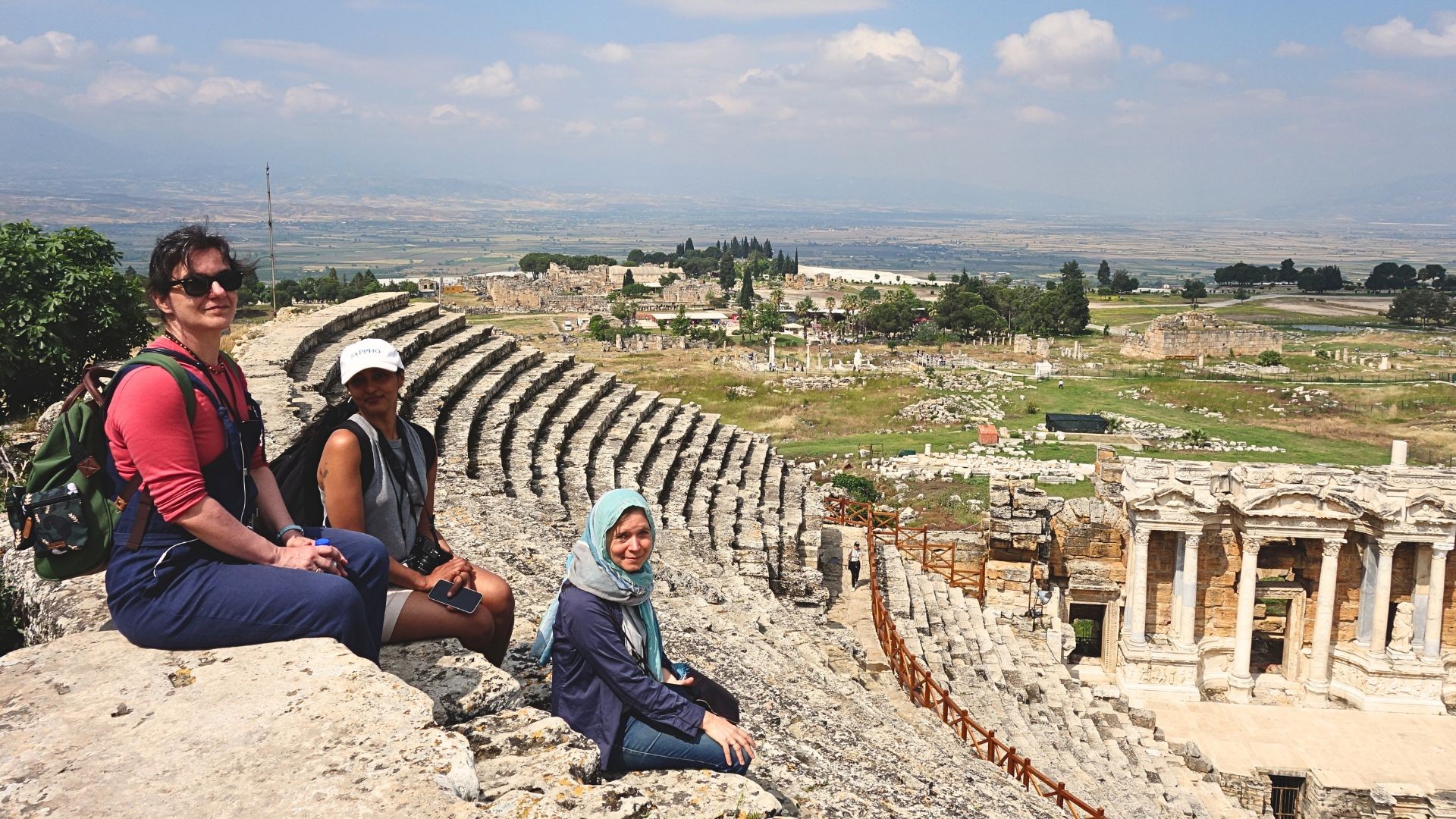
The next stop for the day was the ancient city of Laodicea, once known as Diospolis during the Hellenistic period, meaning the “City of Zeus.” Laodicea thrived as a significant metropolis with a substantial population and immense wealth. The city’s importance was also evident in its architecture, including long columned streets, agoras, three temples, two theaters, and the largest stadion in Anatolia.
We were intrigued by the presence of one of the Seven Churches of Anatolia, which held religious significance in early Christianity and were mentioned in the Book of Revelation. The connection to the biblical figure of John the Apostle, who penned seven letters to these churches, added a layer of depth to our visit. As we explored this site, we discussed the legacy of faith and the intertwining of religion and history.

From learning about the customs surrounding death to encountering one of the most important heritages of early Christianity at Laodicea, the historical significance of these sites was undeniable. At the end of this day, we embarked on a three-hour journey, driving towards our destination for the coming day.
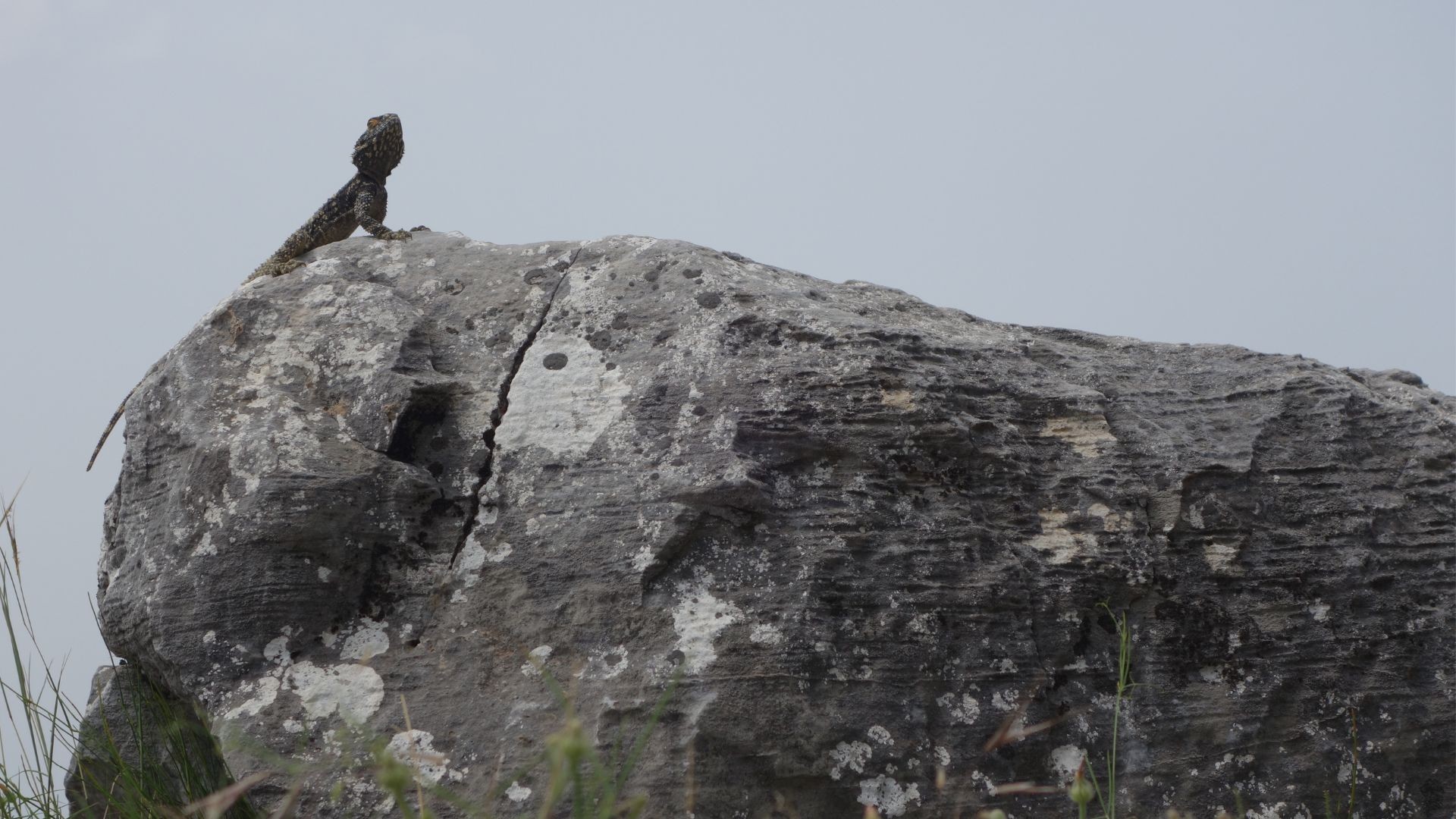
Our day unfolded at the ruins of Priene, a city nestled amidst breathtaking nature. Built on the giant terrains of Mount Samsun or Samson, presumably named after the Biblical hero, Priene embraced the rugged landscape with remarkable harmony and was intimately connected with its surroundings. The buildings were of unparalleled craftsmanship. The stonework left us in awe, prompting us to ponder how such magnificent stones were extracted and transported from the nearby cliffs.
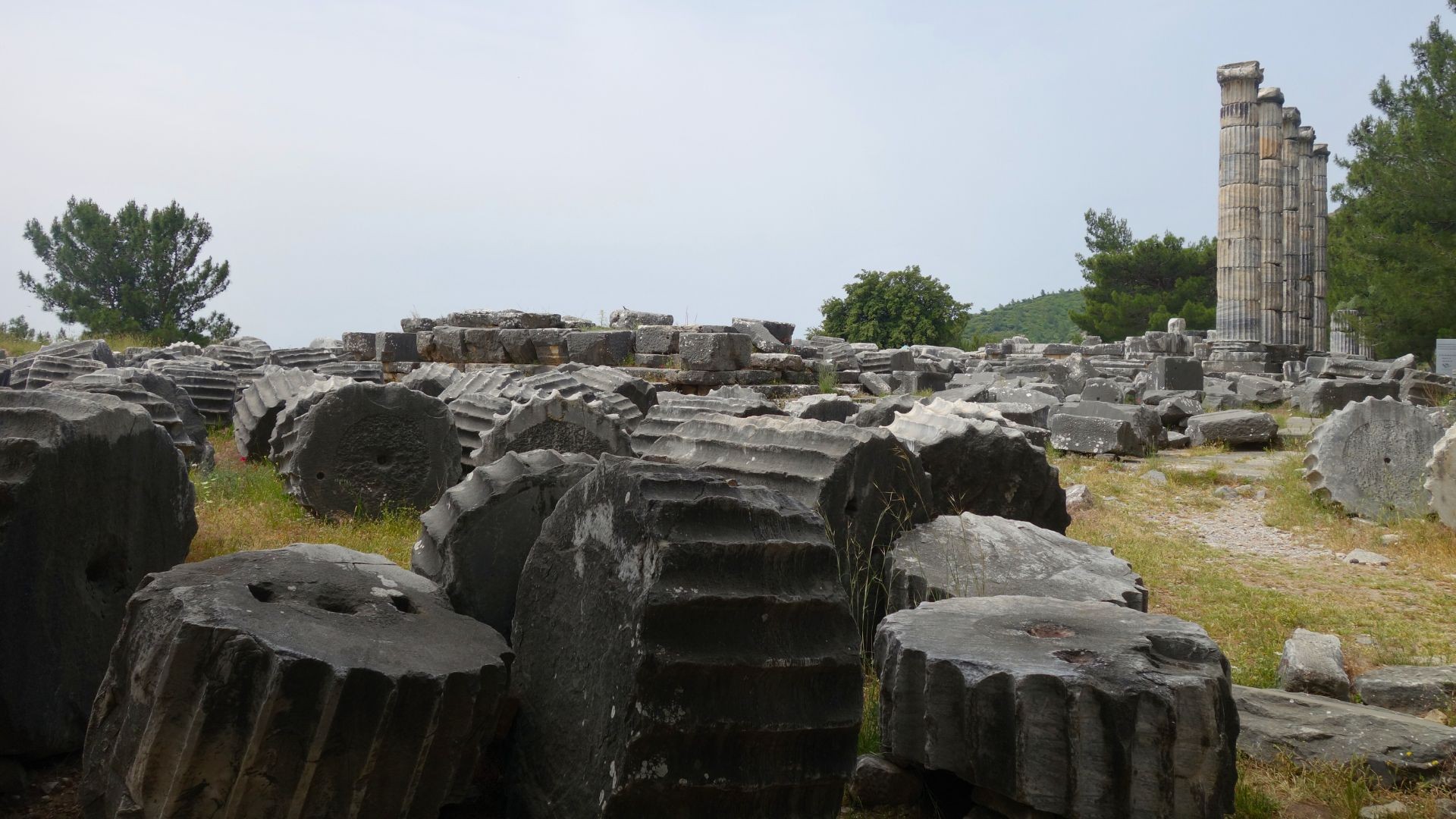
Our exploration led us first to the sanctuary dedicated to Egyptian gods within the city. Here, we came upon inscriptions and artifacts that paid homage to the deities of Isis, Serapis, and Anubis. The presence of an Egyptian temple within an Anatolian city might seem unusual, but it reflects the cultural and religious interactions that thrived in Asia Minor during ancient times. Such intermingling was not uncommon, highlighting the diversity of the region. Trade routes connected different civilizations and facilitated the exchange of goods and ideas, playing a crucial role in fostering cross-cultural connections. This vibrant exchange enhanced the richness of its cities like Priene.
A little ahead, the city’s horseshoe-shaped theater stands, dating back to the mid-3rd century BCE, constructed soon after Priene’s foundation. While it has undergone various modifications both by the Greeks and Romans throughout centuries, the ruins still indicate defining characteristics of Hellenistic theaters. The seating area for around 6,000 people was carved into the natural slope of the hill and is still intact.
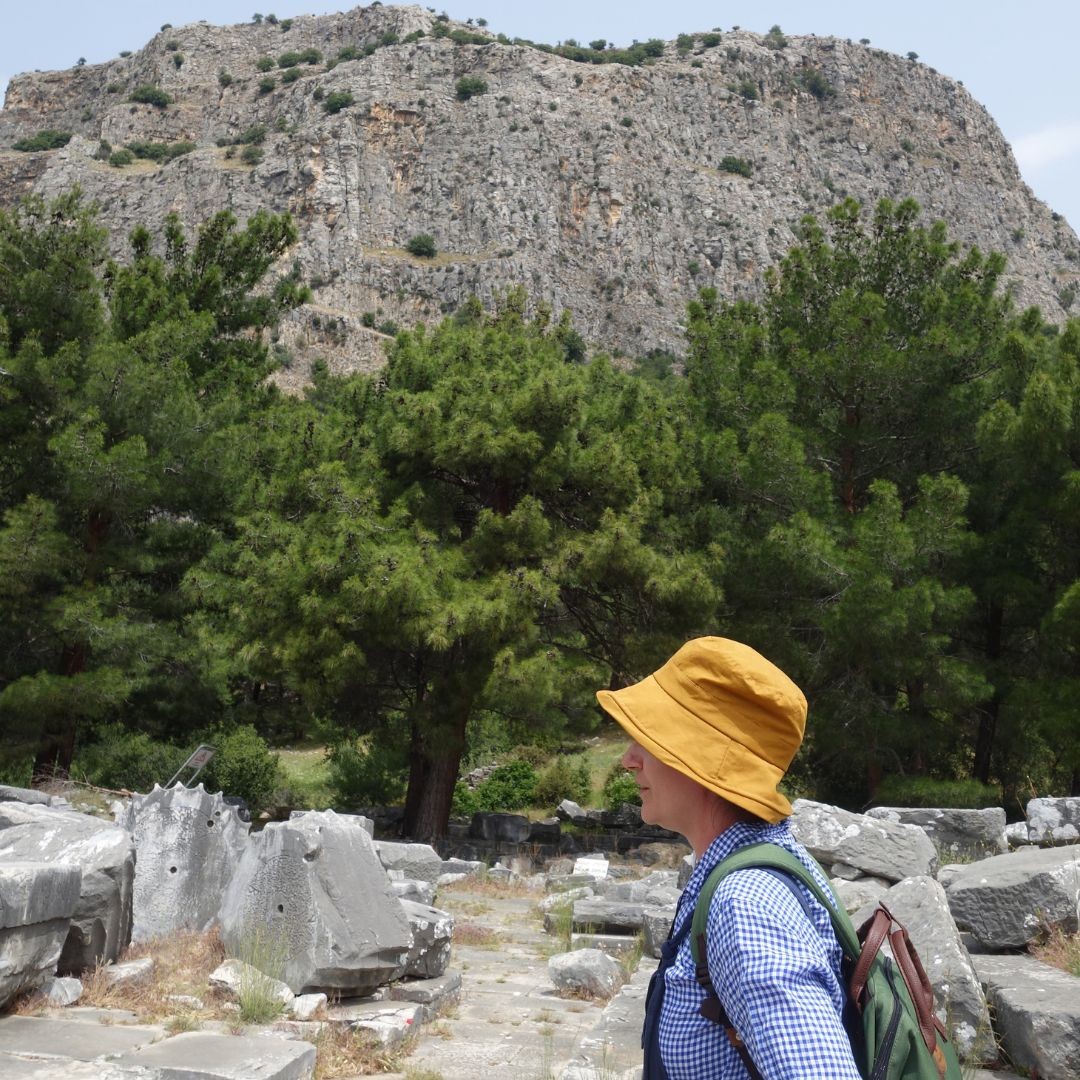
Moving forward in the day, we arrived at Claros at a distance of 60 kilometers from Priene. Surrounded by fruit gardens, the fertility of the area is still evident today, painting a vivid picture of the region’s agricultural prosperity back in time.

The Temple of Apollo shows that Claros was yet another center of prophecy, like Delphi and Didyma. Divine guidance to most pressing questions was sought within these sacred grounds, but unlike other oracles in ancient Greece, Claros had a distinct practice where only men served as diviners.
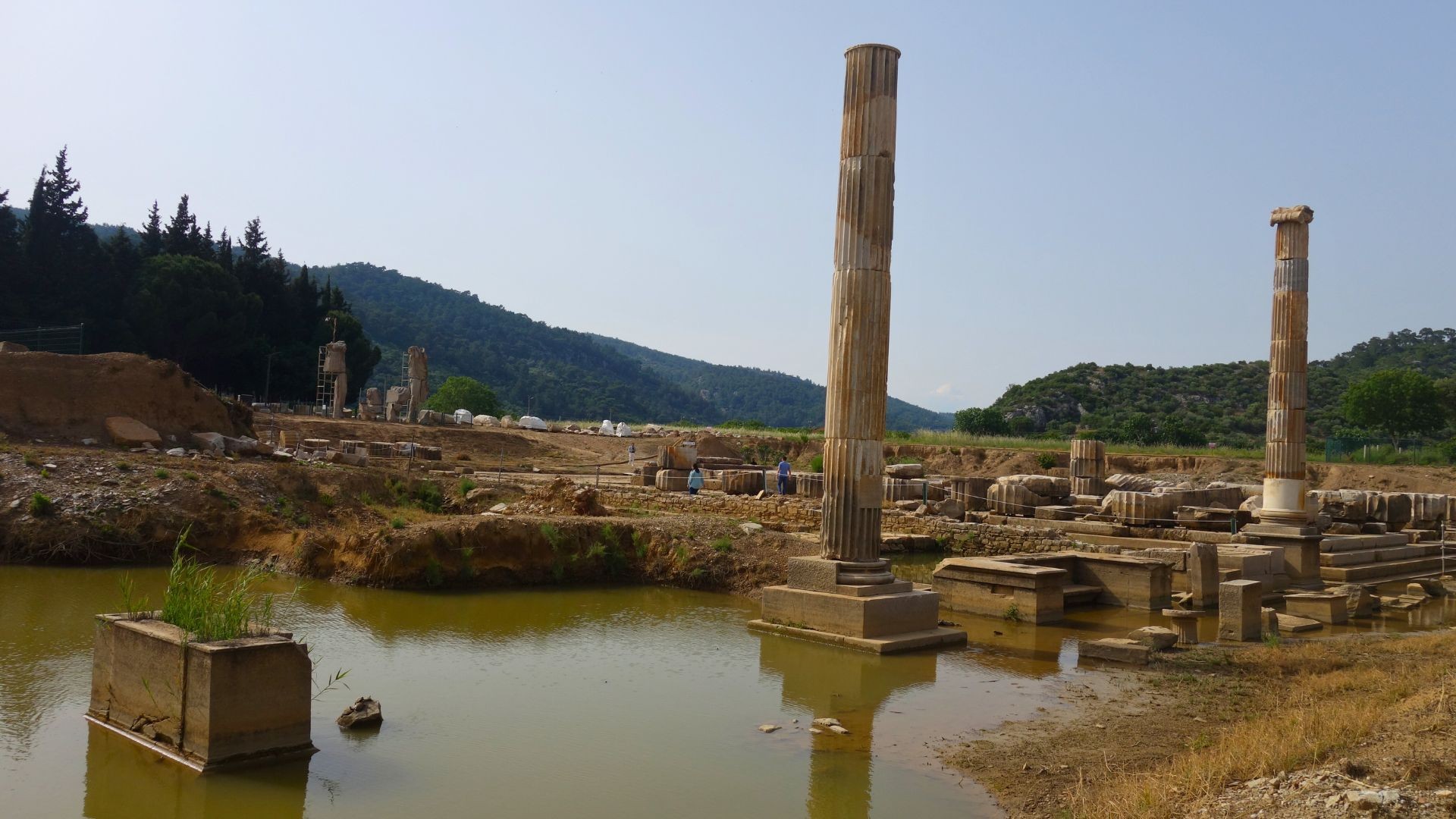
We also discovered the unique katagogeion, a structure next to the Temple serving as a guesthouse for pilgrims and travelers, of which there were plenty in Claros. Travelers were required to book their room in advance and pay the necessary amount to stay in the katagogeion, which was equipped with a bath and a kitchen.
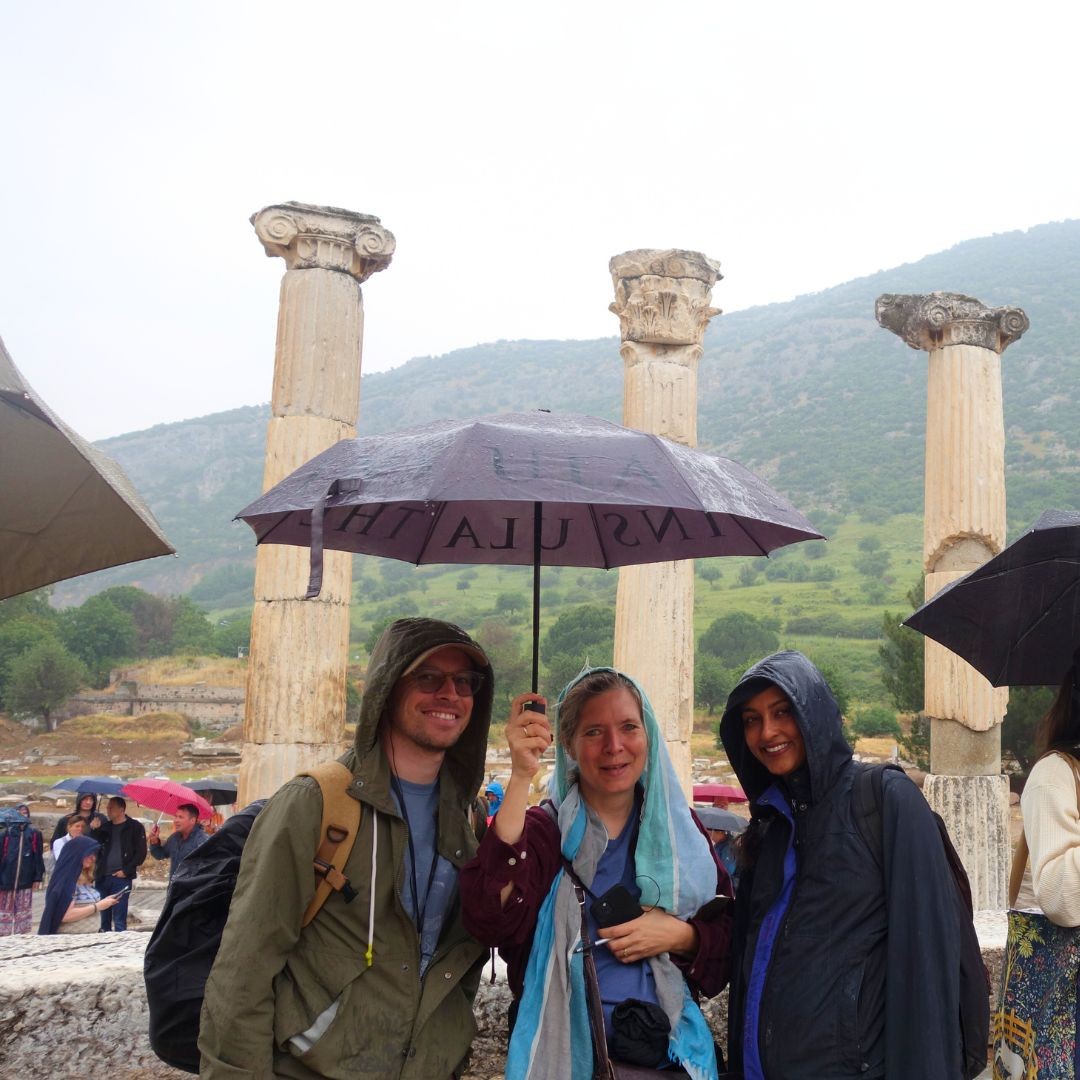
On our fifth day, our destination was Ephesus, an ancient metropolis with a complex history. The city was originally founded near an ancient sanctuary dedicated to the earth goddess Artemis, and this structure is among the Seven Wonders of the Ancient World. It has later undergone two relocations and the one that stands today is from the Roman Empire. Located at the western endpoint of the Royal Road, the primary highway in the Roman East, Ephesus held a vital position as a crucial hub for exporting goods to the Roman West. The city was a religious and cultural center.
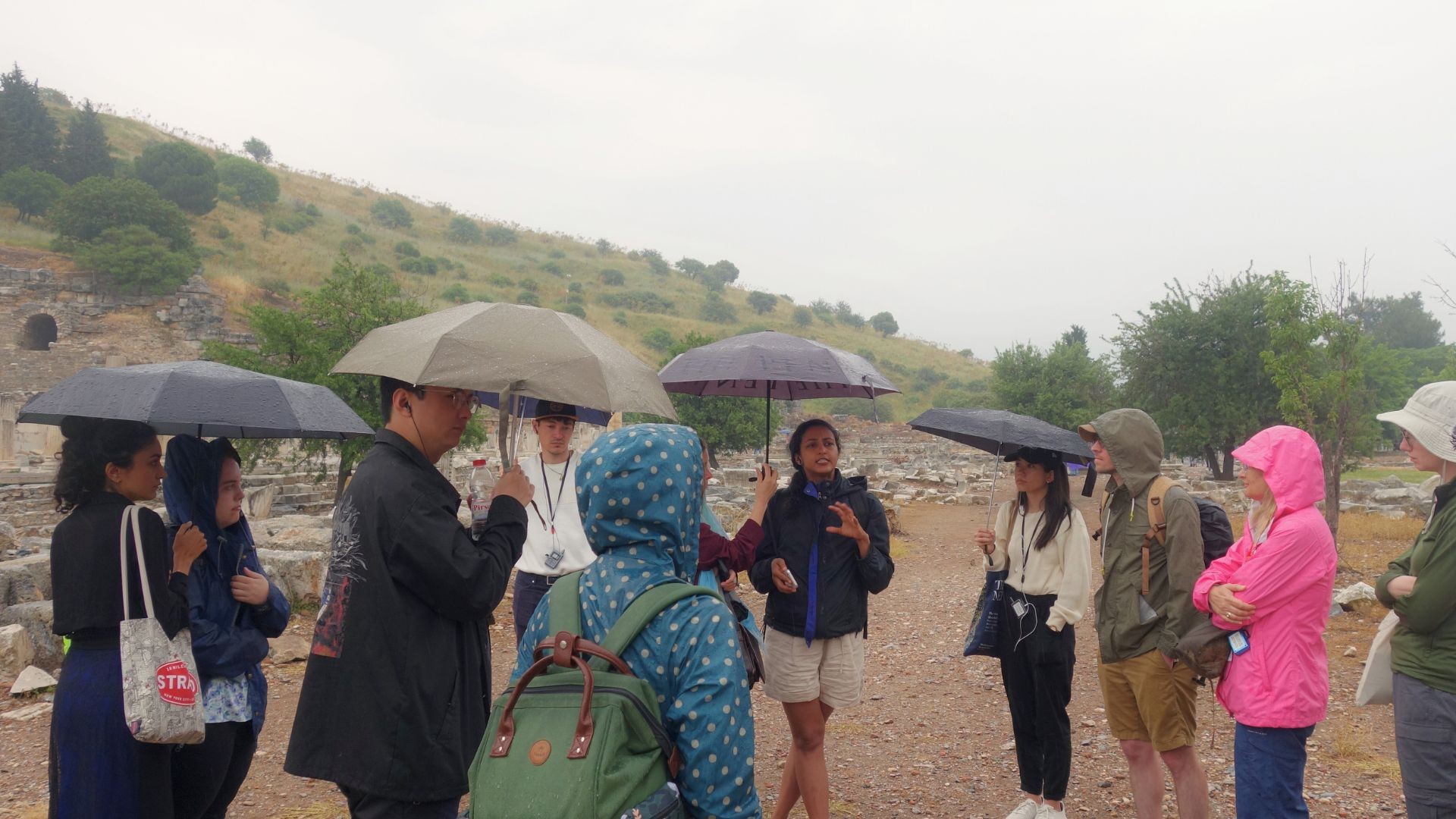
One of the highlights of the day was how our presenter for the day, John Izzo, Ph.D. Student, Classics, drew attention to the large population of enslaved and formerly enslaved people that lived in the city. He was particularly interested in studying monuments and inscriptions of formerly enslaved people and told us how Ephesus has been an important center of slave trade.
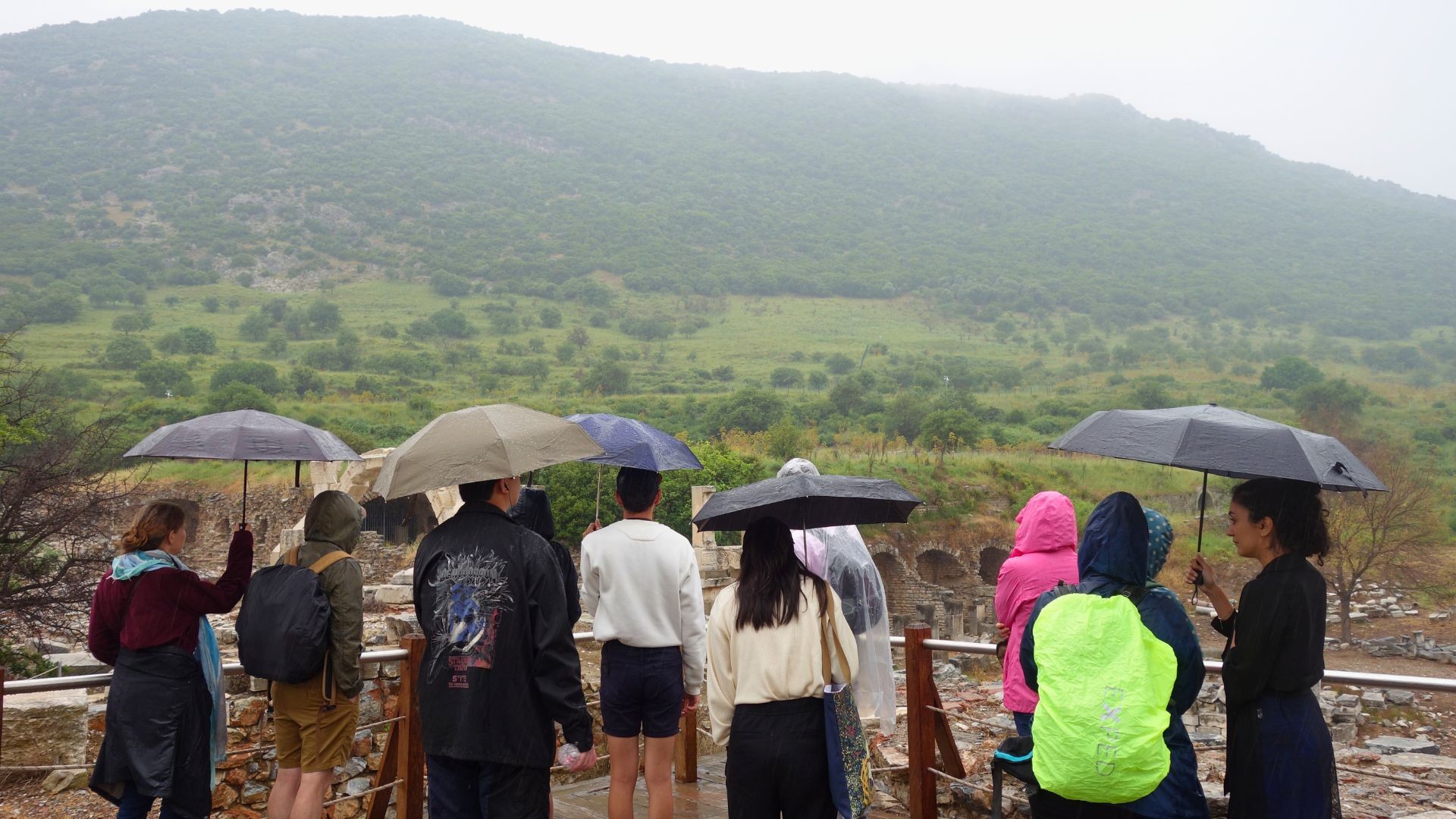
On the other hand, the Terrace Houses offered us a glimpse into the lives of the wealthy residents of this ancient site. These luxurious houses built to the slope of a hill are decorated with magnificent frescoes and mosaics. The artistry of some of these depictions, particularly the lion and bird figures with vibrant colors and details, left a deep impression on every one of us.

The Library of Celsus is yet another distinctive building in Ephesus, standing as a beacon of knowledge and learning. It used to house an impressive collection of more than 12,000 scrolls that enriched the intellectual pursuits of the city’s inhabitants. Though the library’s original collection is no longer intact, its renovated façade and architecture continue to inspire visitors.
Continuing our journey, we arrived at Ephesus’s enormous theater with a capacity of around 25,000 people, believed to be the largest in the ancient world. The construction of this structure began in Hellenistic times. The theater was then renovated and enlarged by the Romans. Today it still hosts performances to its modern audience, for them to witness the acoustics of this ancient construction.

The grand finale of our Ephesus expedition was the Basilica of St. John, a site intertwined with the legacy of John the Apostle himself. It is believed that John lived in Ephesus around 40 CE and that he brought Mary, the mother of Jesus, to this very place. The Basilica itself was built later, by Justinian I in the 6th century CE. Standing within the walls of the Basilica was exciting and helped us better comprehend the rich cultural heritage of the region.
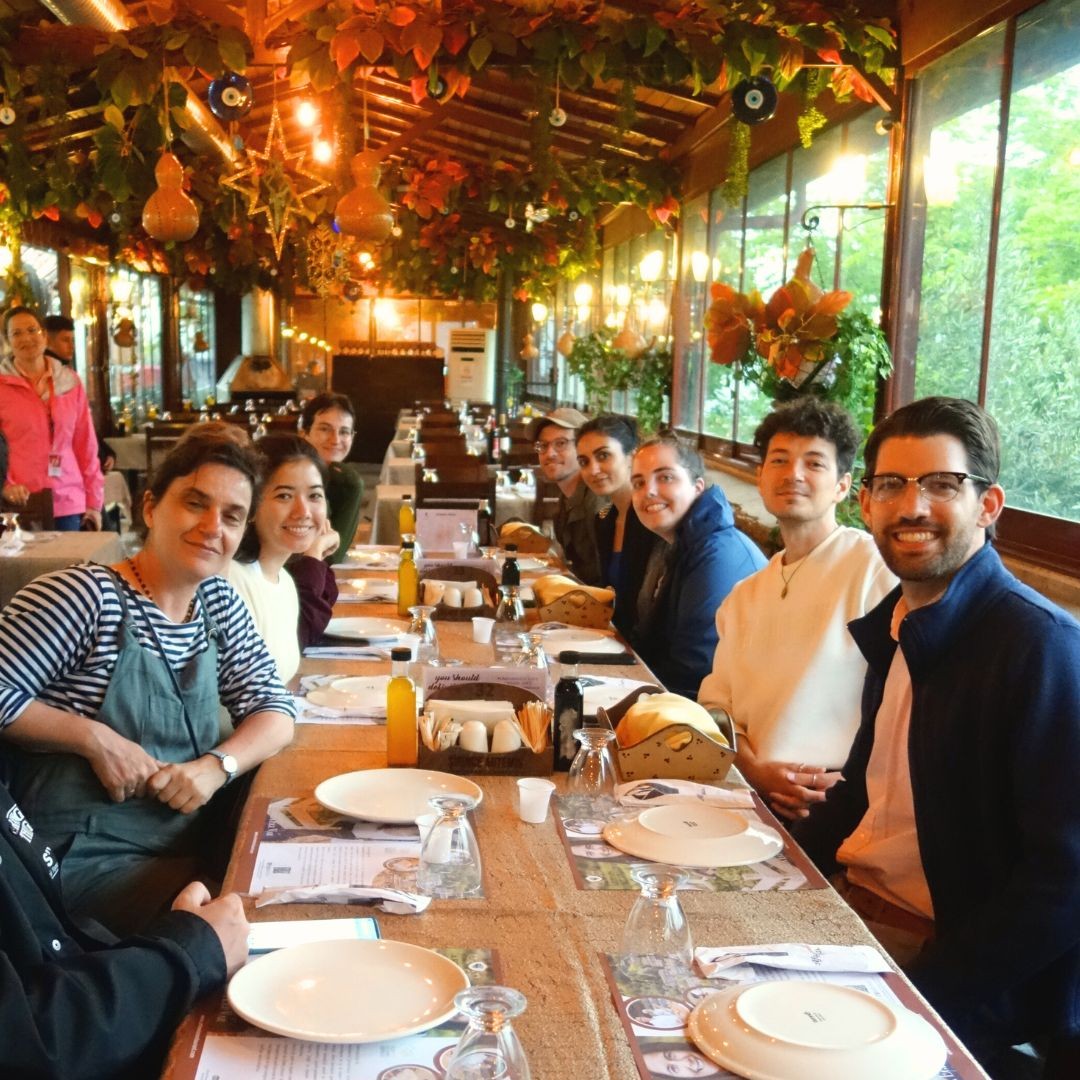
Our day concluded in the charming town of Şirince, a place with a rich history dating back to the Hellenistic period. Today, Şirince thrives through its agricultural practices, producing fruit wines and olive oil. As the sun set, the renowned wines of the region accompanied us as we reflected on the day.
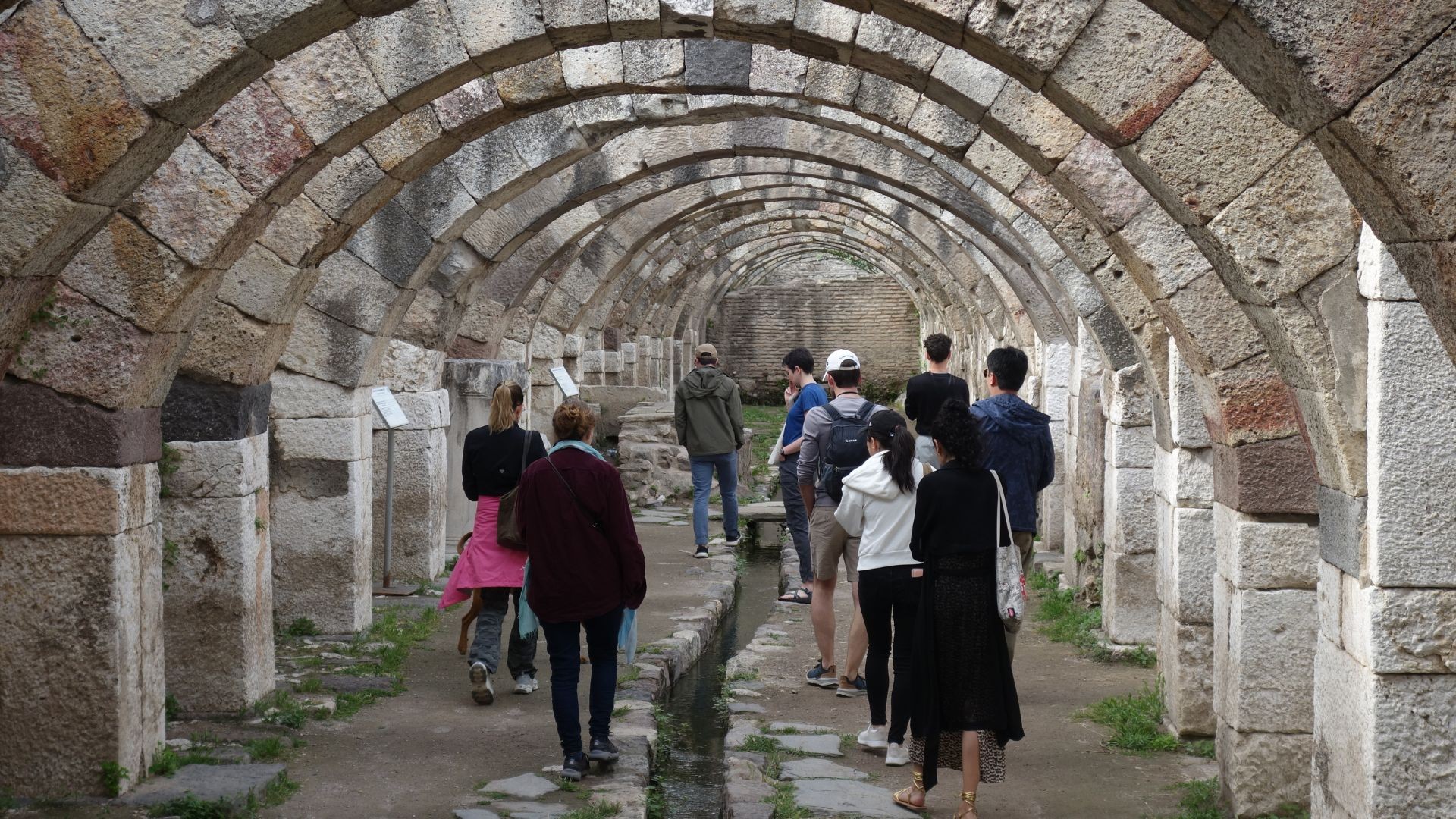
We set off to Smyrna on a beautiful morning, the ancient city from which modern-day İzmir derives its name. Originally established around the 11th century BCE, Smyrna underwent significant transformation. The legend surrounding its relocation adds an intriguing dimension to the city’s history. Our presenter for the day, Shenda Kuang, Ph.D. Student, Classical Studies, mentioned the accounts of the renowned traveler and geographer Pausanius. It is said that Alexander the Great, while hunting in the vicinity, fell asleep beneath a tree and dreamt of founding a city in this very spot. Inspired by his vision, he decided to move the city of Smyrna here. Seeking guidance, the Smyrnaens consulted the revered oracle of the Apollo Temple at Claros, one of our stops from the earlier days, who prophesied that those who move there would experience three to four times greater happiness.
Located at modern İzmir’s heart, Smyrna’s agora is one of the largest of its kind. It was built during the Hellenistic era but was destroyed by a major earthquake afterwards. The Roman emperor Marcus Aurelius rebuilt the agora and nearly all remains belong to public buildings of that period.
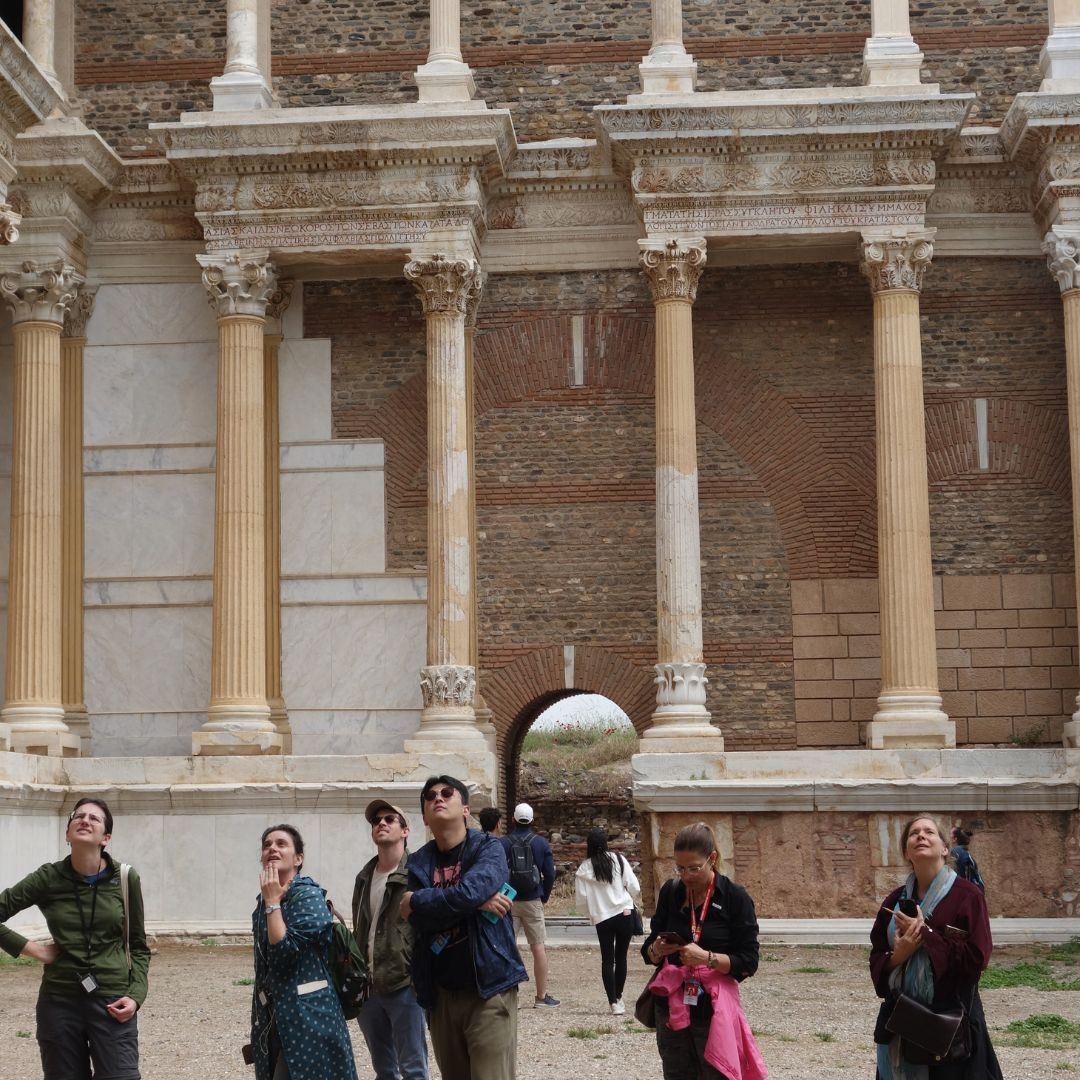
The second ancient site we visited was the nearby city of Sardis, the capital of Lydian civilization, where we traced stories on the origins of money. The Pactolus River used to run by the ancient city of Sardis, and was famous for its alluvial gold, making Lydians the wealthiest people around.
Visiting the mint and the Lydian industrial sector outside city walls, we encountered the earliest known ateliers where electrum, a naturally occurring alloy, was separated into pure gold and silver. The earliest coins made of solid gold were known throughout the ancient Greek world as “Croeseids,” after the Lydian king who introduced them. Our group underlined the workmanship of these coins and their intricately crafted lion and bull heads. The indentations on them used to reveal their weight, percentages of gold and silver, and ultimately their value, providing us with insights into the ancient monetary system.

The gymnasion in Sardis, our next stop, was one of the largest in Asia Minor. It served not only as a place for bathing but also as a social hub for ceremonies. This bath building covering 23,000 square meters had gold-colored inscriptions and marble columns, reflecting the city’s prosperity and status as a crossroad of imperial trade routes.
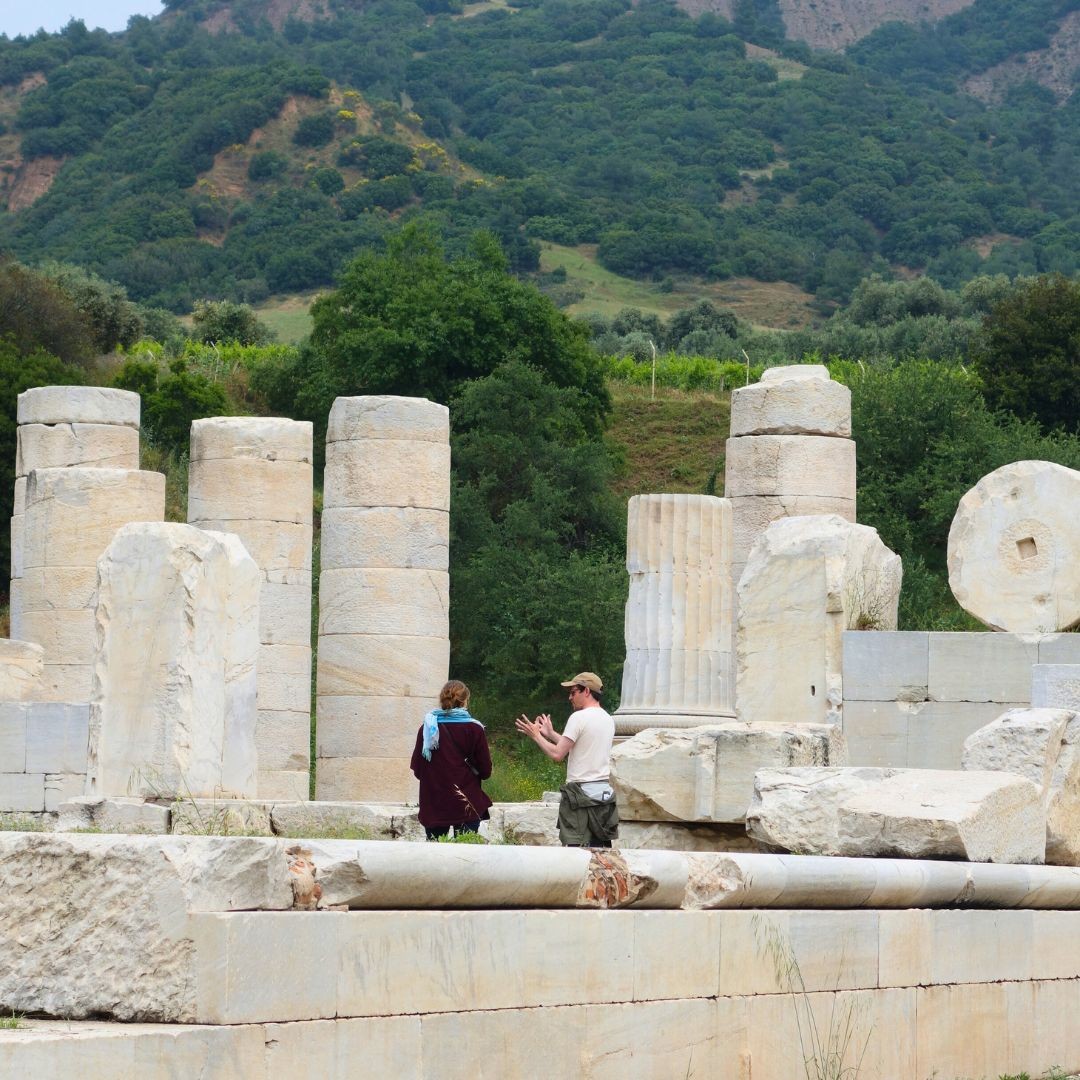
Our final destination for the day was the Artemis Temple. Particularly intriguing was the construction techniques employed in antiquity. We were astonished to learn about where marble quarries were and how they were transported to the city, how blocks weighing up to 23 tons were lifted and placed with specially built lewis. We witnessed the technique of ancient architects using iron clamps and dowels to securely join neighboring blocks.
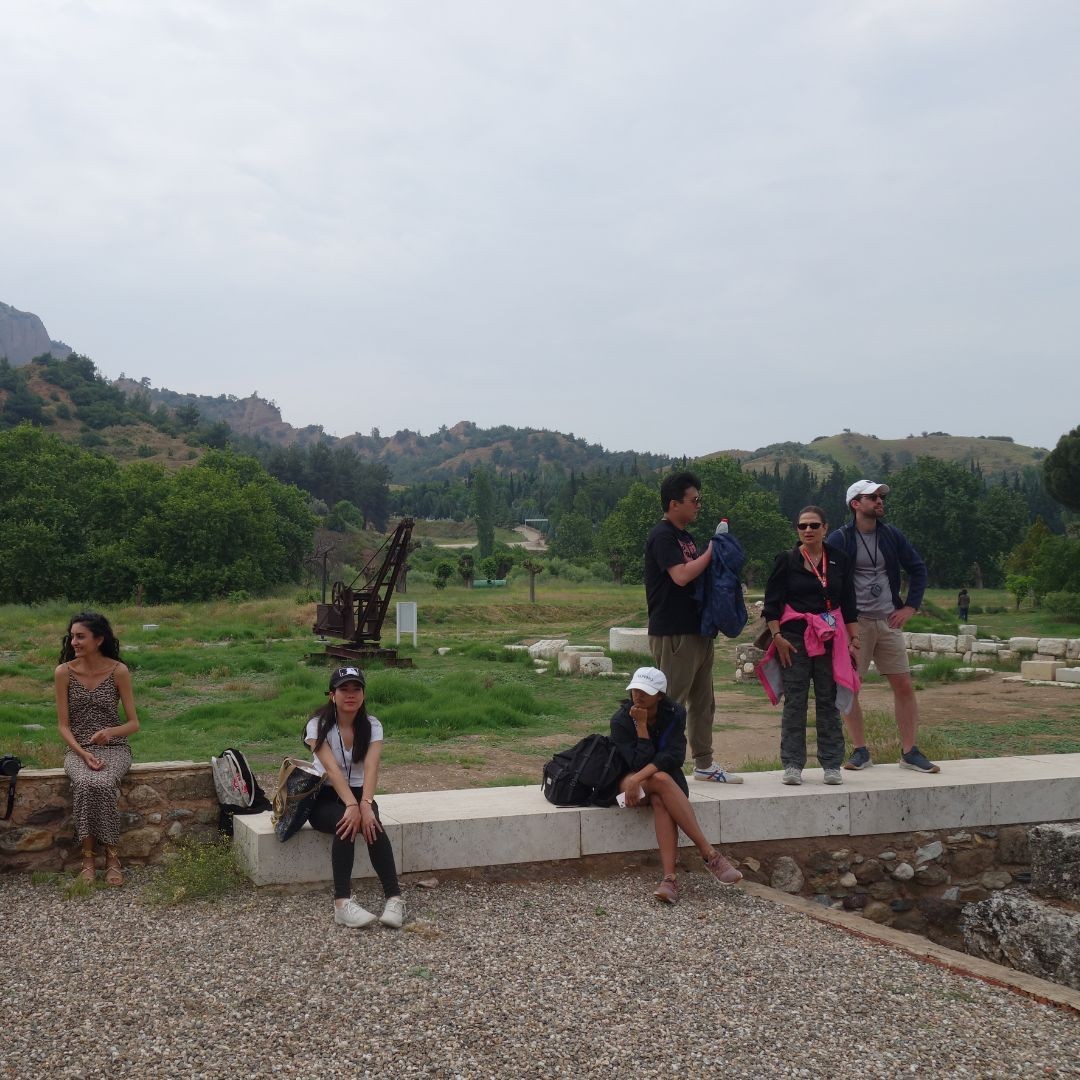
Adding another layer to our odyssey was the crane near the temple from the 1907 excavations, serving as a reminder of the efforts undertaken to unearth these wonders. This discovery sparked discussions about the methods employed by archaeologists throughout history.
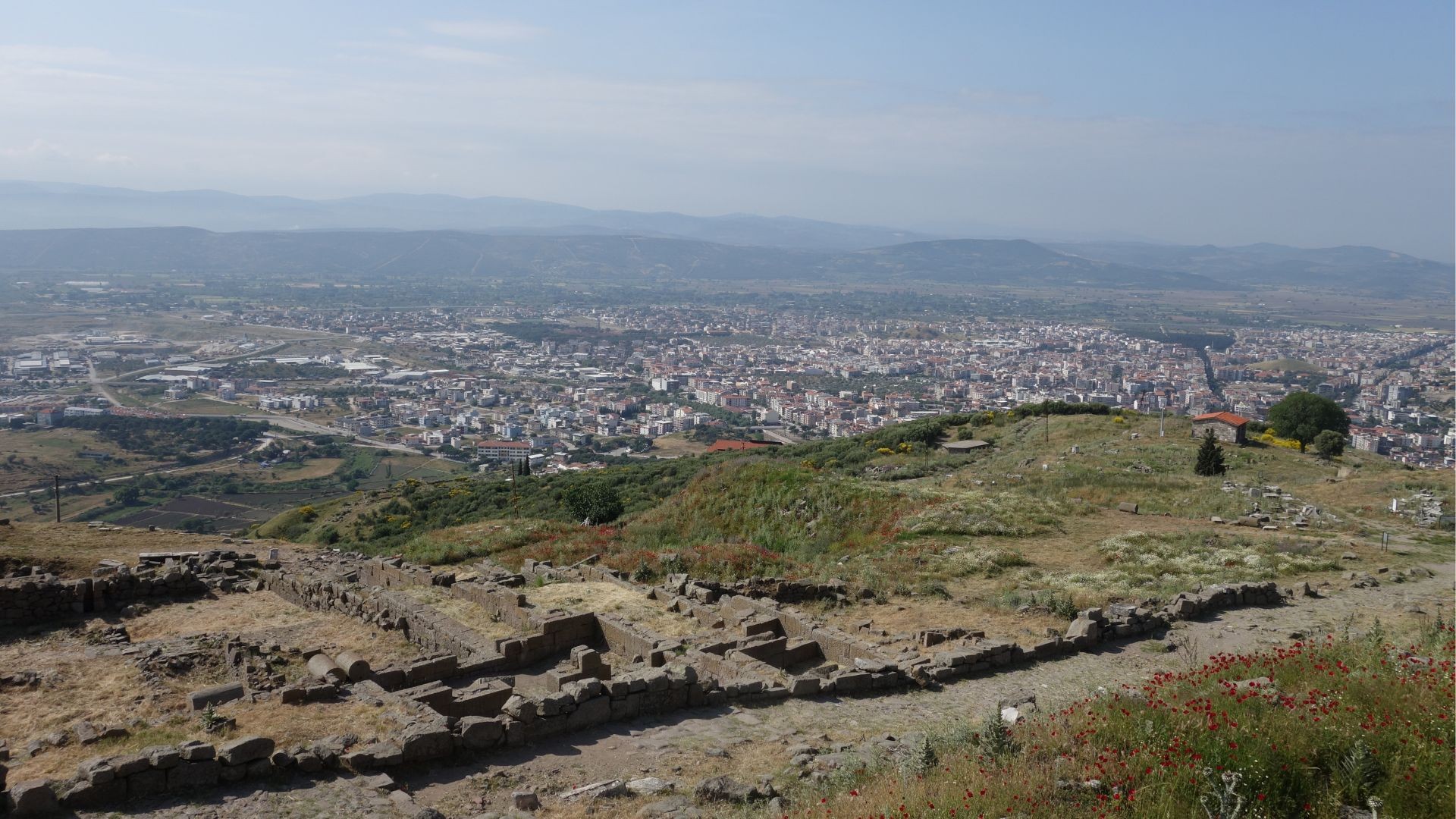
Our seventh day was solely devoted to the city of Pergamon. The journey began with a cable car ride to the pinnacle of the Pergamon acropolis, located on a mountainside. The city’s name, believed to have originated from the Hittite era, signifies its position as a “high city” or a “citadel”.
On this day, we had the privilege of being guided by Ayelet Gila Wenger, Ph.D. Student, Classical Studies. As we were climbing up, someone asked: How did the citizens of this town navigate their way to the top, and, more intriguingly, how did they transport the colossal marbles? Ayelet said that this was a question that had not occurred back in the library, where theater seat capacities and various dates seemed more important. We delved into a discussion about the significance of elevation and its role in shaping the city’s appearance.

Providing fresh water to hilltop citadels such as Pergamon also posed a perpetual challenge during ancient times. We talked about the aqueducts and pressurized water pipelines that provided Pergamon with a reliable water supply. These feats of ancient engineering demonstrate the city’s advanced infrastructure and water management systems.
At the summit, we continued with a discussion on the importance of the Great Altar, the remains of which are now at the Pergamon Museum in Germany. This iconic structure was decorated with a frieze showing the battle between the Giants and the Olympian gods.
Next, we went to the well-preserved theater of Pergamon, a masterpiece from the Hellenistic period. With its 36-meter height and capacity to accommodate approximately 10,000 spectators across 78 rows of seats, it is one of the steepest ancient theaters. The adjacent terrace below the theater offers a wide panorama. A marble temple sits right next to the theater on a podium, around 5 meters and 25 marble stairs above the level of the theater terrace, which is dedicated inevitably to Dionysus.
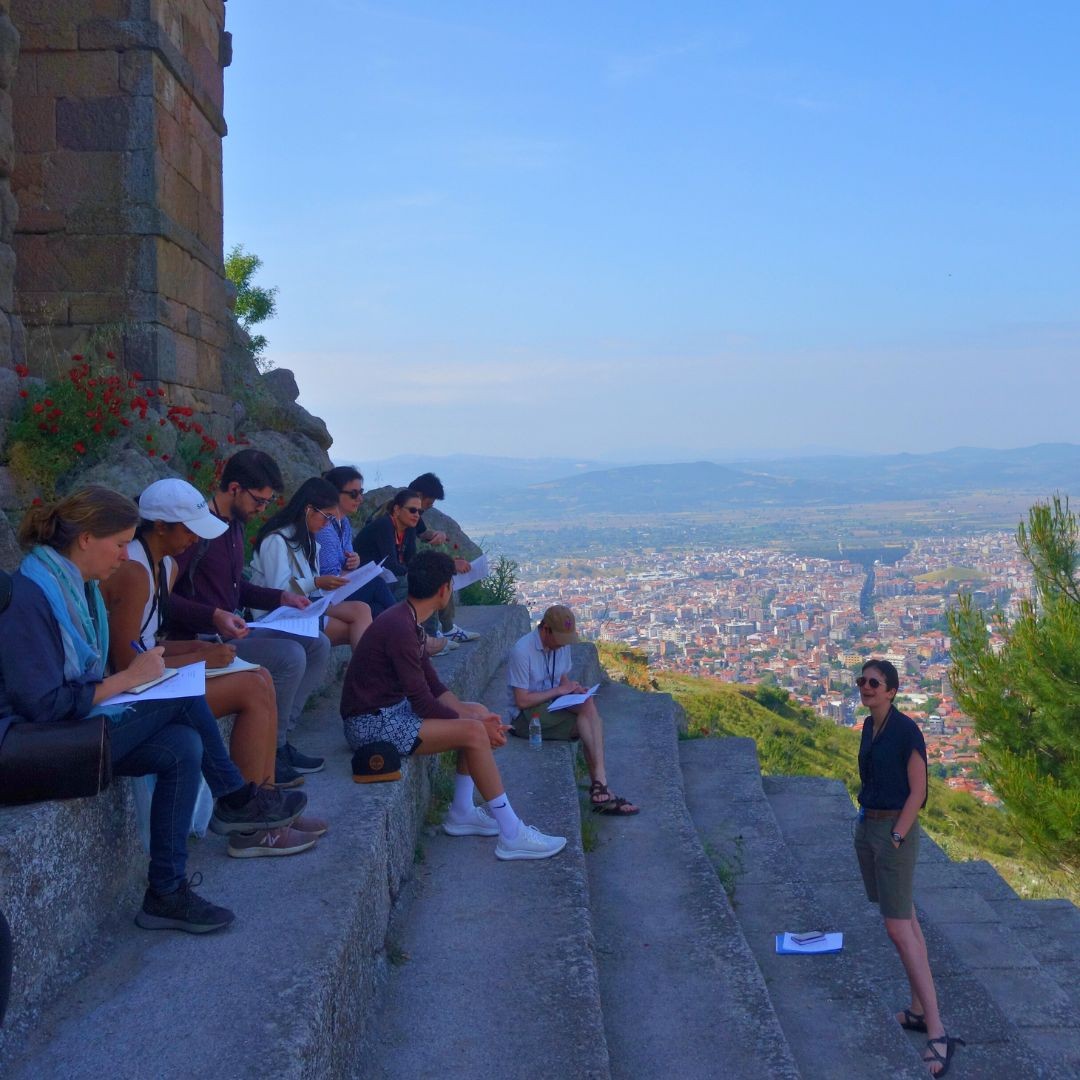
Continuing our journey down the hill, we encountered the great temple of the Egyptian deities Isis and/or Serapis, commonly known today as the “Red Basilica.” Though concealed by the modern Bergama town, the vast courtyard of this architectural complex is estimated to span approximately 200x100 meters. The remnants of its towering brick structures still hold firm and are of immense size. Notably, the extensive use of red brick, a rarity in Asia Minor, suggests that the architect behind this building may not be of local origins.
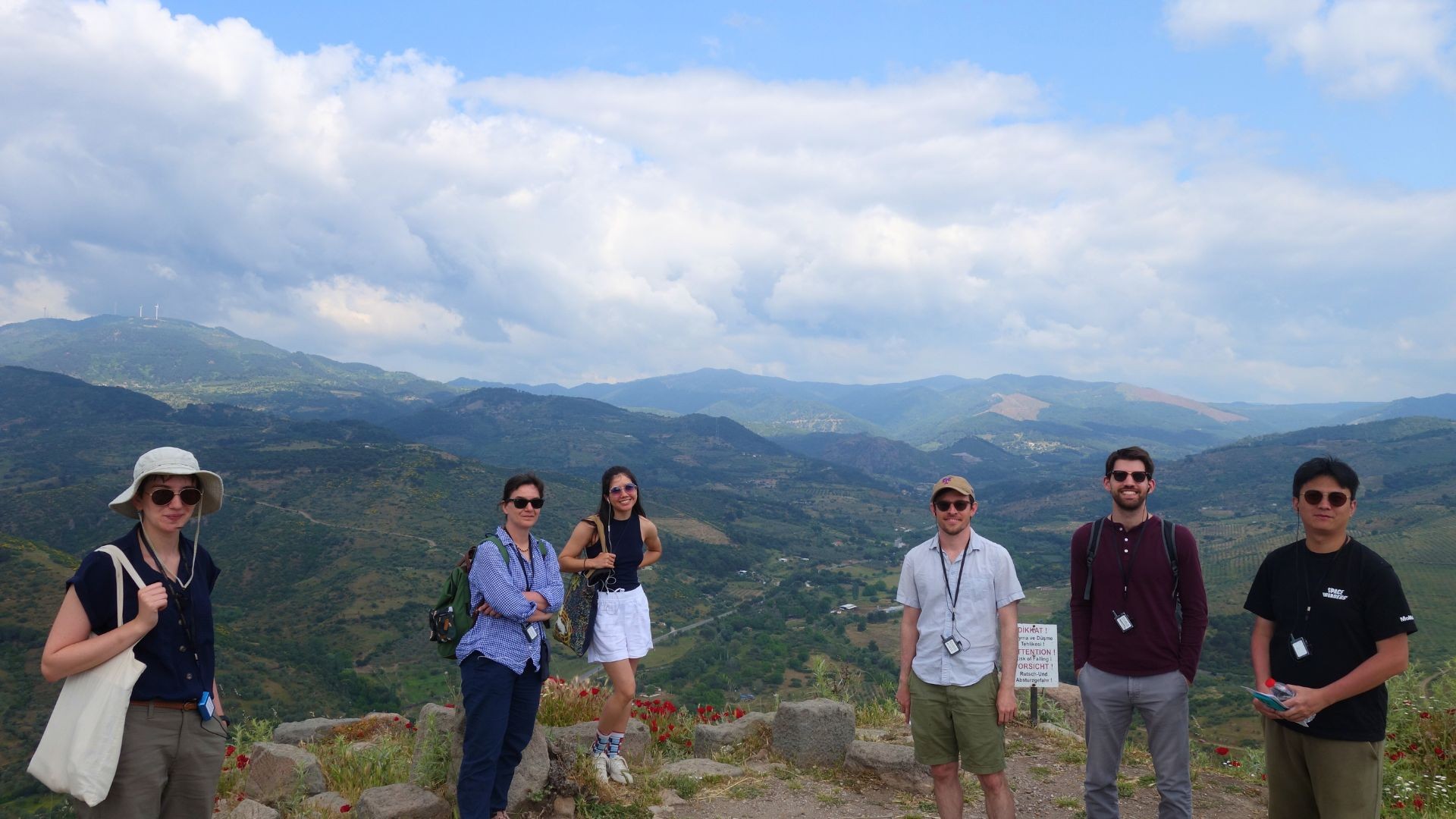
Our final destination within Pergamon was the Asklepieion. Following the colonnaded sacred road, above which the acropolis glides, starts one of the most important treatment centers of ancient times. It was here that individuals seeking cures would bathe in the holy spring, with the hope that the deity Asclepius, the first doctor-demigod in Greek mythology, would appear in their dreams and provide them guidance for recovery.

Ayelet focused on a healing tale recounted by Aelius Aristides, a patient of the Asklepieion in Pergamon. This narrative wove together elements of miracles, healing, and the intersecting realms of medicine and mythology. It also highlighted the profound connection between Roman power, the practice of medicine, and the enduring allure of ancient healing sanctuaries.
As the day drew to a close, we left behind the city of Pergamon and traveled to the picturesque coastal town of Assos.
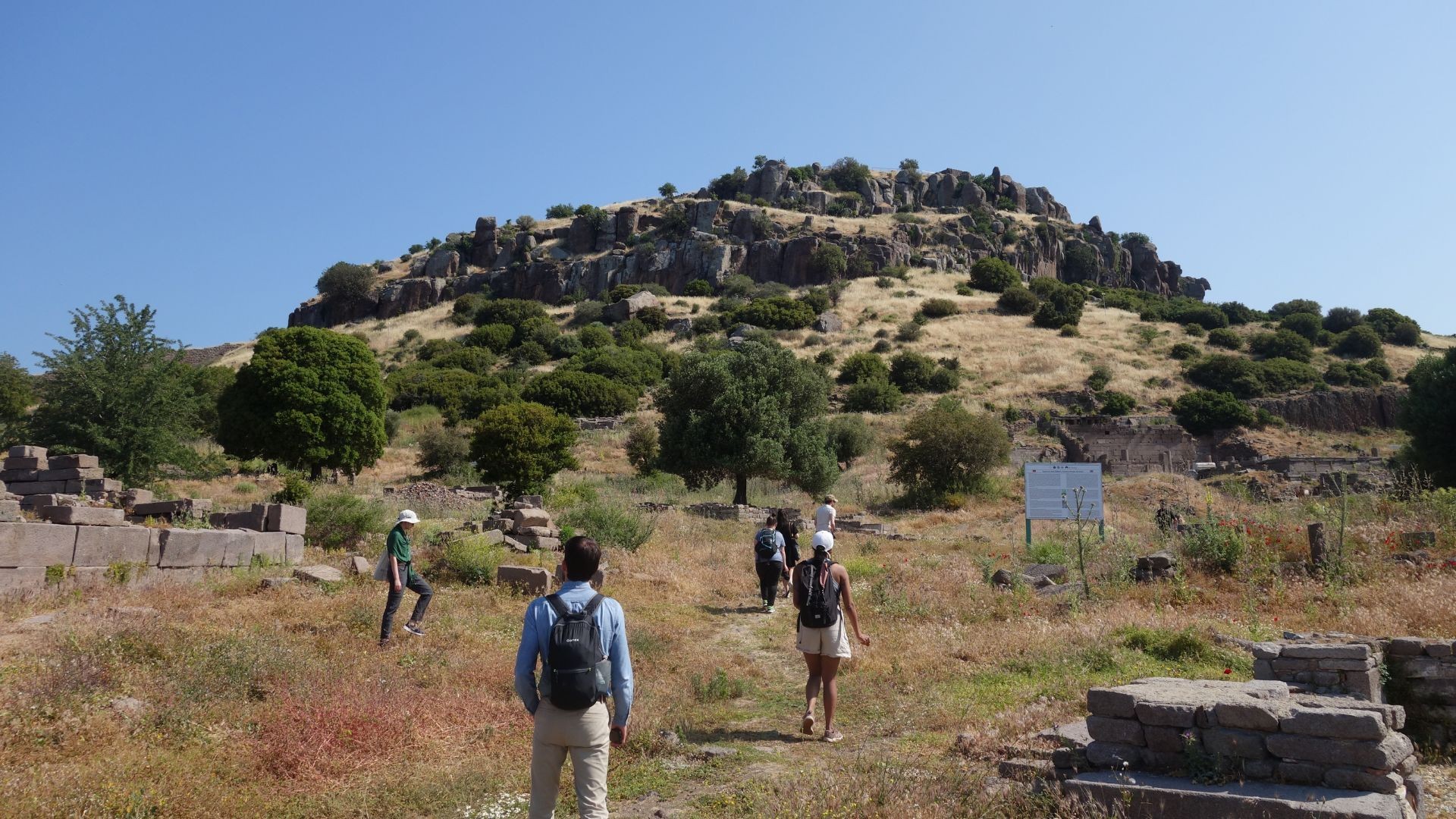
Our journey took us first to Assos, a city that has witnessed numerous conquests throughout its existence. It holds a remarkable position with breathtaking views of Lesbos in the south, Pergamum in the southeast, and the great Mount Ida or modern day Kaz Dağı in the east.
We started the trip from Assos’s acropolis, from the highest point of the city around 234 meters above sea level. One of the first marvels we encountered was the Athena Temple, a unique temple with its Doric style built by Aeolian colonists from Lesbos, who are believed to have founded the city around 9th century BCE. The temple dedicated to Athena, protector of Assos, was covered with friezes that depict the battle between Heracles and a centaur.
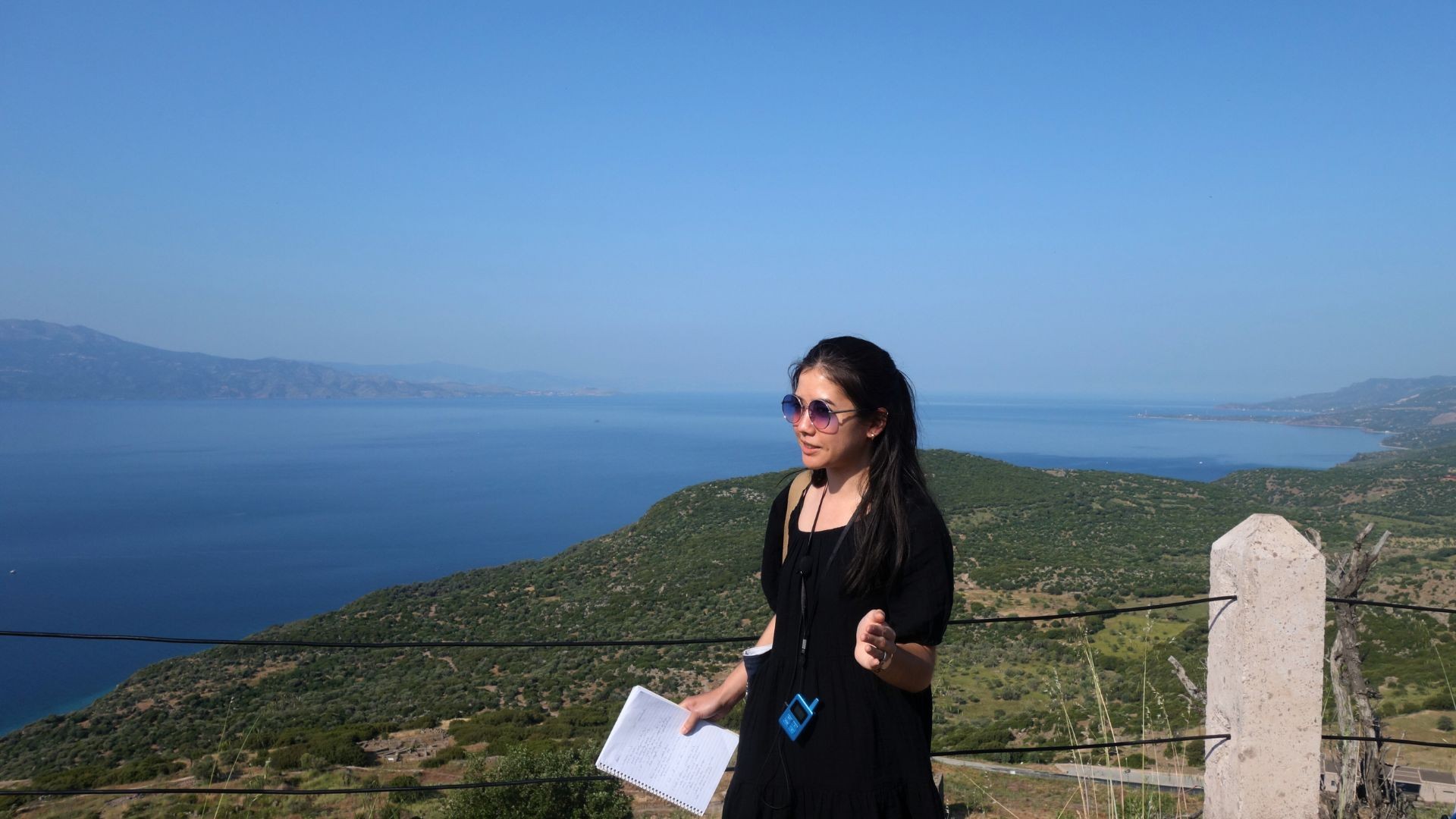
The bouleuterion, translated as council house or the senate, was our next stop. Overlooking the Lesbos Island, this view served our group as a reminder of the legendary poet Sappho who was born there. In honor of her legacy, we remembered her poetic words:
While she lived here beside us she honored you
like a goddess for all to see:
it delighted her most to hear you singing.
Now among all the women of Lydia
she stands out, just as, once the sun’s
finished setting, the rosy-fingered moon
surpasses all the stars, spreading her light alike
on the salt sea and over all
the wide blossoming country meadows.[1]
Assos held another connection to intellectual history as it became the home of Aristotle and the Academy he founded. Here, Aristotle made groundbreaking contributions to the fields of zoology and biology. However, the Persian invasion marked by the murder of his wife, tragically cut his time in Assos short.
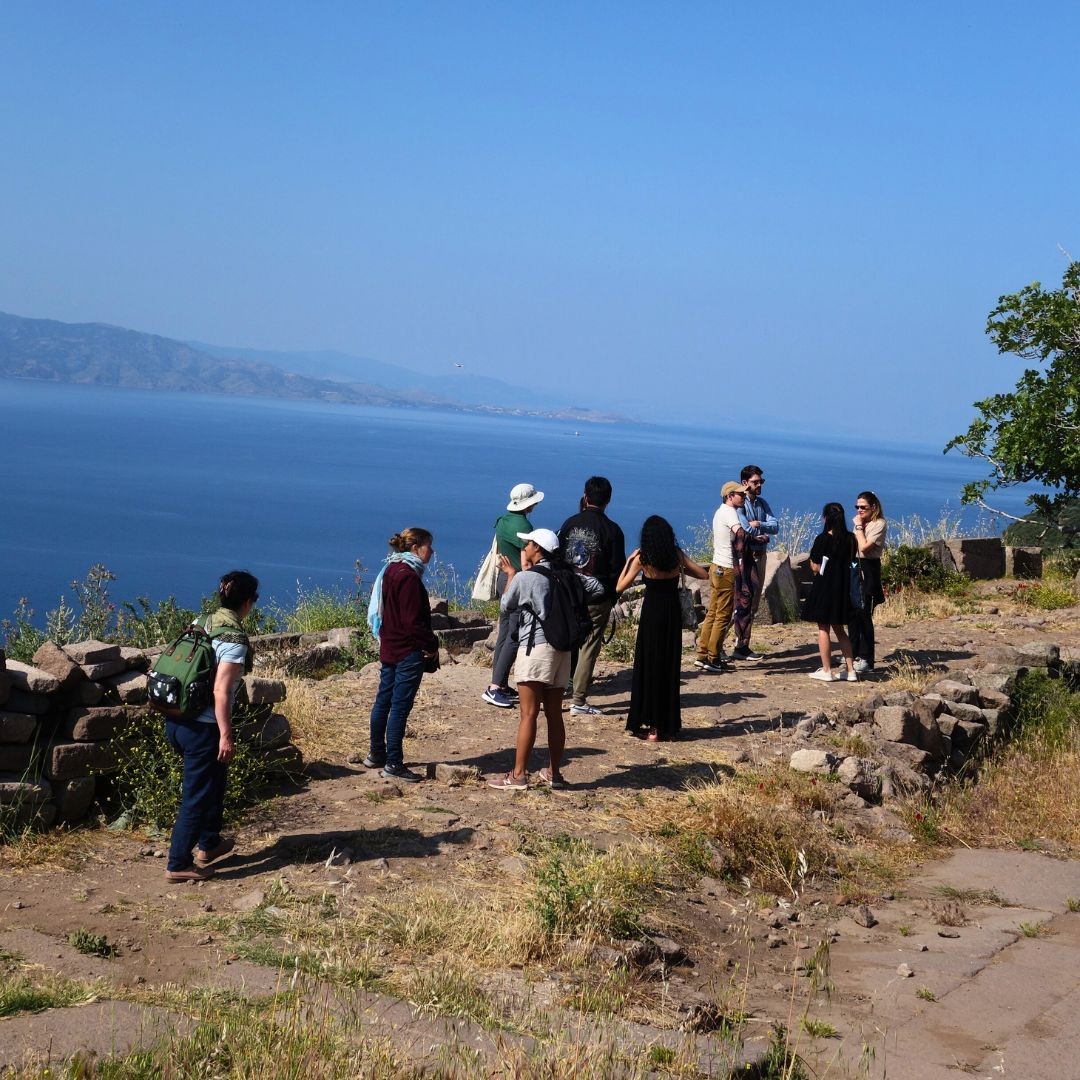
We said farewell to Assos after passing by its necropolis with its intricately crafted sarcophagi. This site was continuously used from the 6th century BCE to the 6th century CE, showcasing tombs from various eras.
Our expedition then led us to the fabled city of Troy, where we first visited the meticulously curated Troy Museum. Melody Anne Wauke, Ph.D. Student, Classics, underlined why visiting the museum was crucial to making more sense of this ancient city’s nine distinct layers corresponding to its nine major periods. Wauke was impressed that the curation of the museum proved very adept at providing a comprehensive historical framework for the visitor to benefit from.

The remains of Troy I, the first layer, suggest that the city was founded around 3,000 BCE. Although not much is known about the first Trojans, earliest findings indicate that Troy had common features with the settlements that lay along the Aegean. Troy II, notable for having been misidentified as Homeric Troy, was known to be larger. Even less is known about Troy III-V, due to careless excavation practices in order to fully unearth the citadel of Troy II. However, these settlements appear to have been smaller and poorer than previous ones. Troy VI-VII encompassed a fortified citadel located on a steep slope, overlooking a sprawling lower town with a significant population. But it was destroyed by a fire. Greek settlers revived Troy VIII, and the Romanized Troy IX was notable for the structures built by Emperor Augustus in 1st century BCE and 1st century CE.
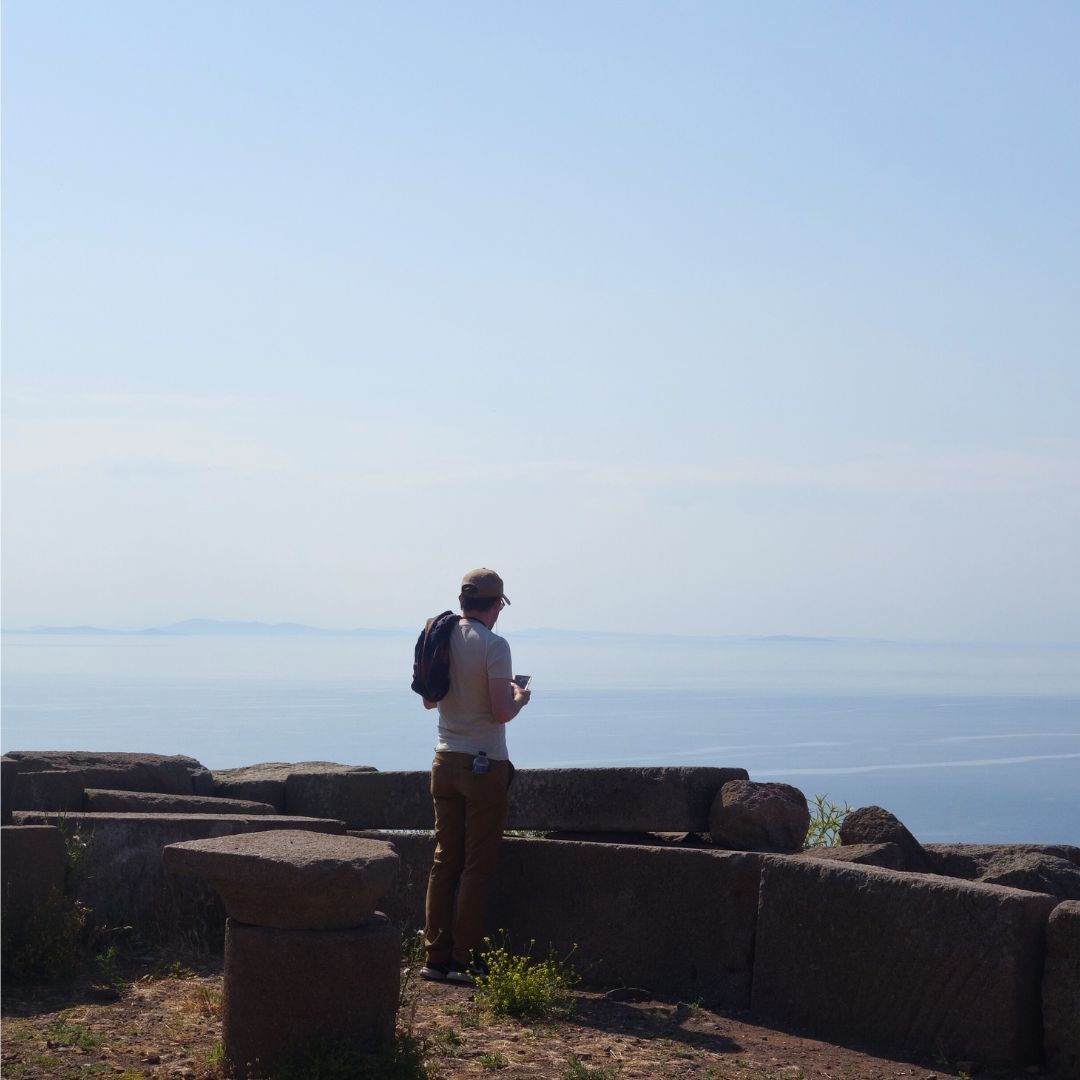
Troy’s most renowned legend, that of the Trojan Horse, came alive as we encountered a replica of this iconic structure at the ancient site. It was unfortunately under construction, but it helped us remember the tale immortalized by Homer’s epic poems, which captures the strategy employed by the Greeks to infiltrate the city after many years of battling, and claim victory.
At the end of the day, we left ancient Troy and the Dardanelles behind to start our journey to Istanbul.
[1] The Poetry of Sappho, translation and notes by Jim Powell, Oxford University Press, 2007.
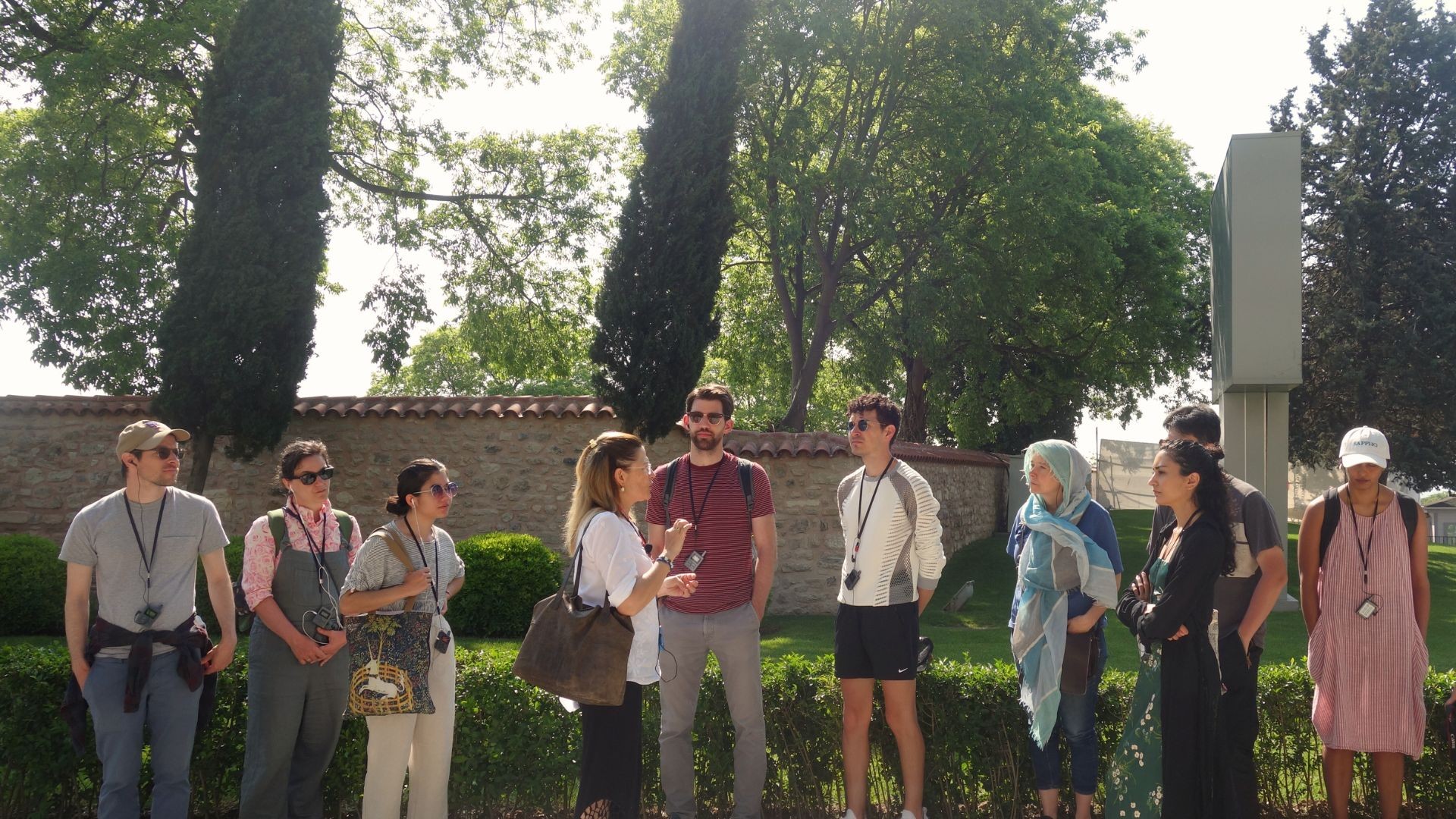
The final day of our trip unveiled the historical wonders of Istanbul, once Constantinople, encompassing Byzantine as well as Ottoman legacies. We commenced our day at the Hagia Sophia. Originally built by Emperor Justinian I between 532 and 537 CE, this magnificent building stands as the third iteration of the cathedral at the same spot, as the prior ones had been destroyed. Isidore of Miletus, renowned architect, whom we encountered in his hometown, contributed to its creation.
Our path led us next to Hagia Irene, the oldest known church in the city today. This Byzantine structure has never been converted into a mosque. It is said to occupy the site of an ancient temple to Greek gods and goddesses, transformed into a church by Emperor Constantine I in the 4th century CE.
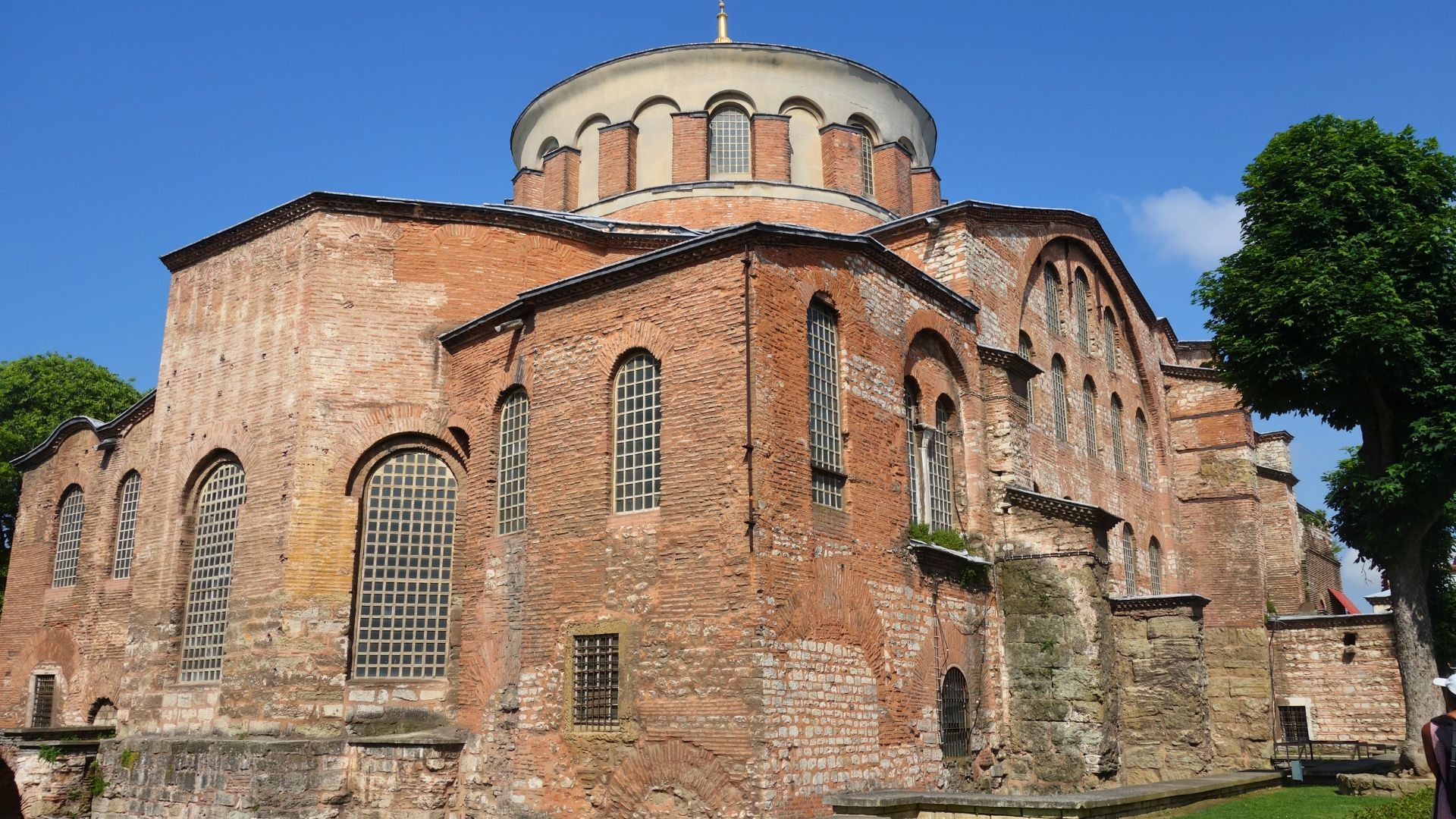
Our next stop was the Basilica Cistern nearby, an underground reservoir. Constructed between the 3rd and 4th centuries CE, this enormous subterranean cistern spans approximately 138 meters by 65 meters and was capable of storing 80,000 cubic meters of water. A forest of 336 marble columns supports the ceiling, two of which bear reused blocks with the enigmatic portrayal of Medusa. While the precise origins of these heads remain a mystery, it is believed that they found their way to the cistern after being relocated from a structure belonging to the late Roman era.
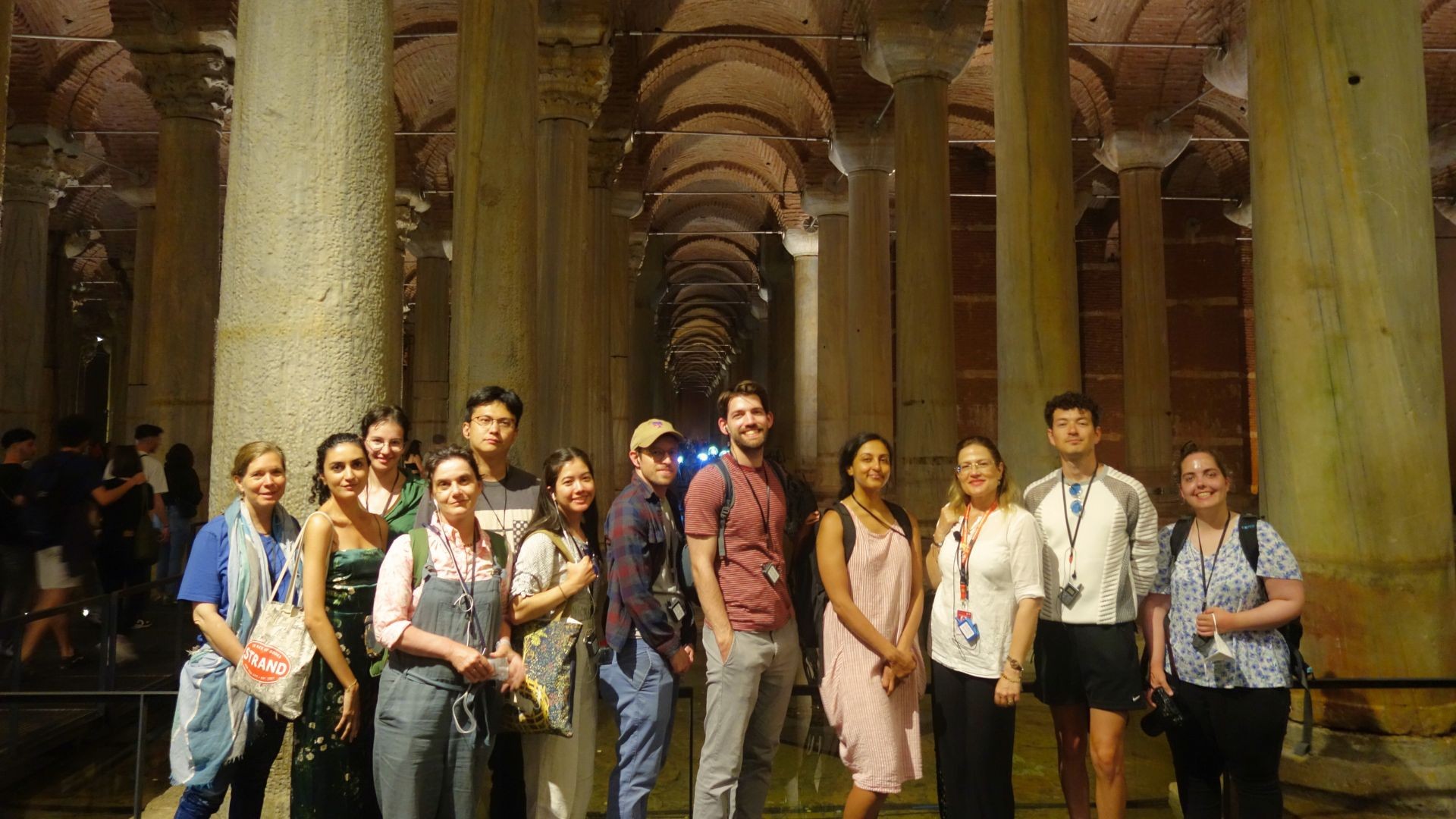
Continuing our way around the ancient sites, we arrived at the Hippodrome of Constantinople. Stretching approximately 450 meters in length and 130 meters in width, it was capable of accommodating 100,000 spectators. Statues of gods, heroes, and emperors decorated it, with remnants still visible today.
The Serpent Column was one of these. Erected to commemorate the Greeks’ triumph over the Persian Empire, this ancient bronze trophy was relocated from Delphi to Constantinople. Just next to it is another monument, this time from ancient Thebes, the Obelisk of Theodosius. Thought to be built by Pharaoh Tuthmosis III in the 15th century BCE, the Obelisk found its new home after more than a thousand years in Constantinople. Rising to a height of nearly 19 meters, it symbolized Rome’s victory over the Egyptian civilization.
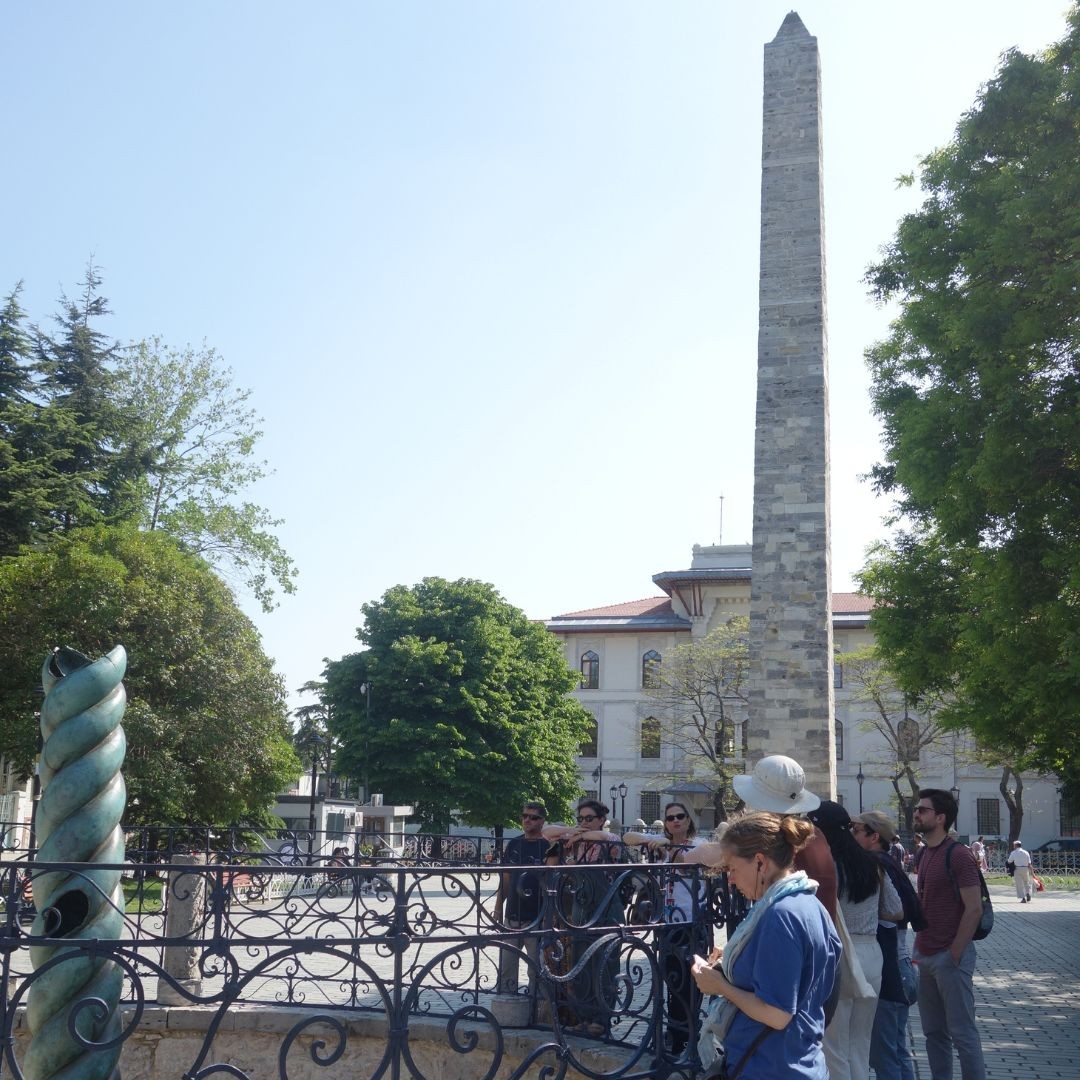
During our final day, we also explored the Topkapı Palace Museum and the Grand Bazaar, two landmarks from the Ottoman era. The majestic halls and artifacts of the Ottoman palace showed us the grandeur of the Empire. The still bustling marketplace showed how centuries-old commercial traditions continued.
Ellen Morris, Associate Professor, Classics, one of the faculty members organizing the trip, is mainly an Egyptologist who focuses on ancient imperialism. During our visit to the Topkapi Palace, she referred to the common features of ancient Egyptian and modern Ottoman empires in terms of promoting and maintaining their royal power. Her remarks about how divinely ordained rulers cultivate an air of mystique around their power to encourage obedience informed our every step at the palace.

While the day drew to a close, we reflected upon the layers of history that shaped Istanbul. From the Byzantine marvels of Hagia Sophia and Hagia Irene to the subterranean mystique of the Basilica Cistern, and the Hippodrome, each site bore witness to the city's enduring legacy. Our journey through time was enriched by the echoes of more recent empires and the stories they left behind.
After traveling around numerous sites and delving into the depths of time together for nine days, our odyssey through history and architectural wonders of the Eastern Mediterranean had come to a close in Istanbul, an apt final destination. Though parting ways was difficult, it was with gratitude we said goodbye, cherishing the memories forged during our adventure.